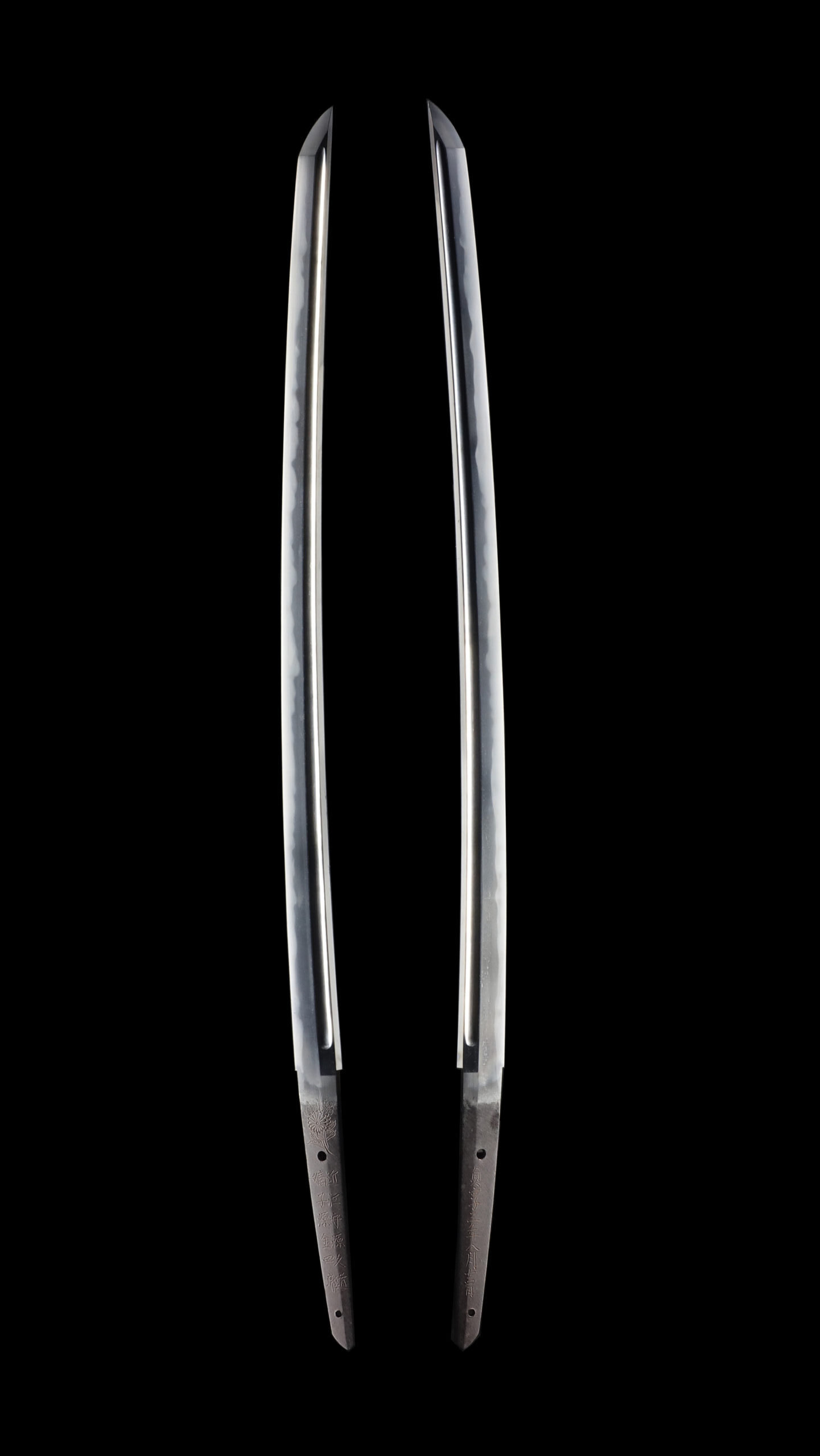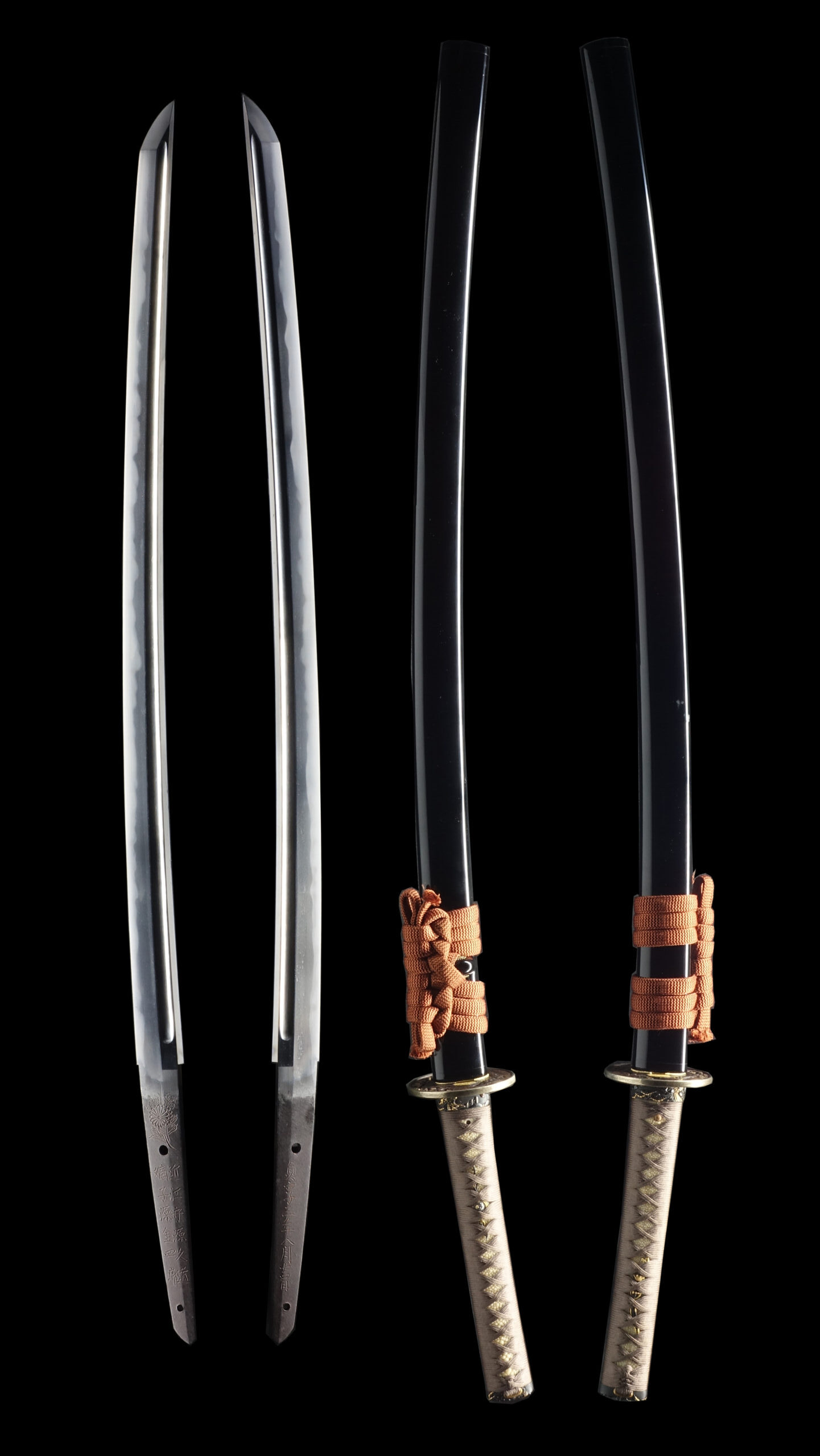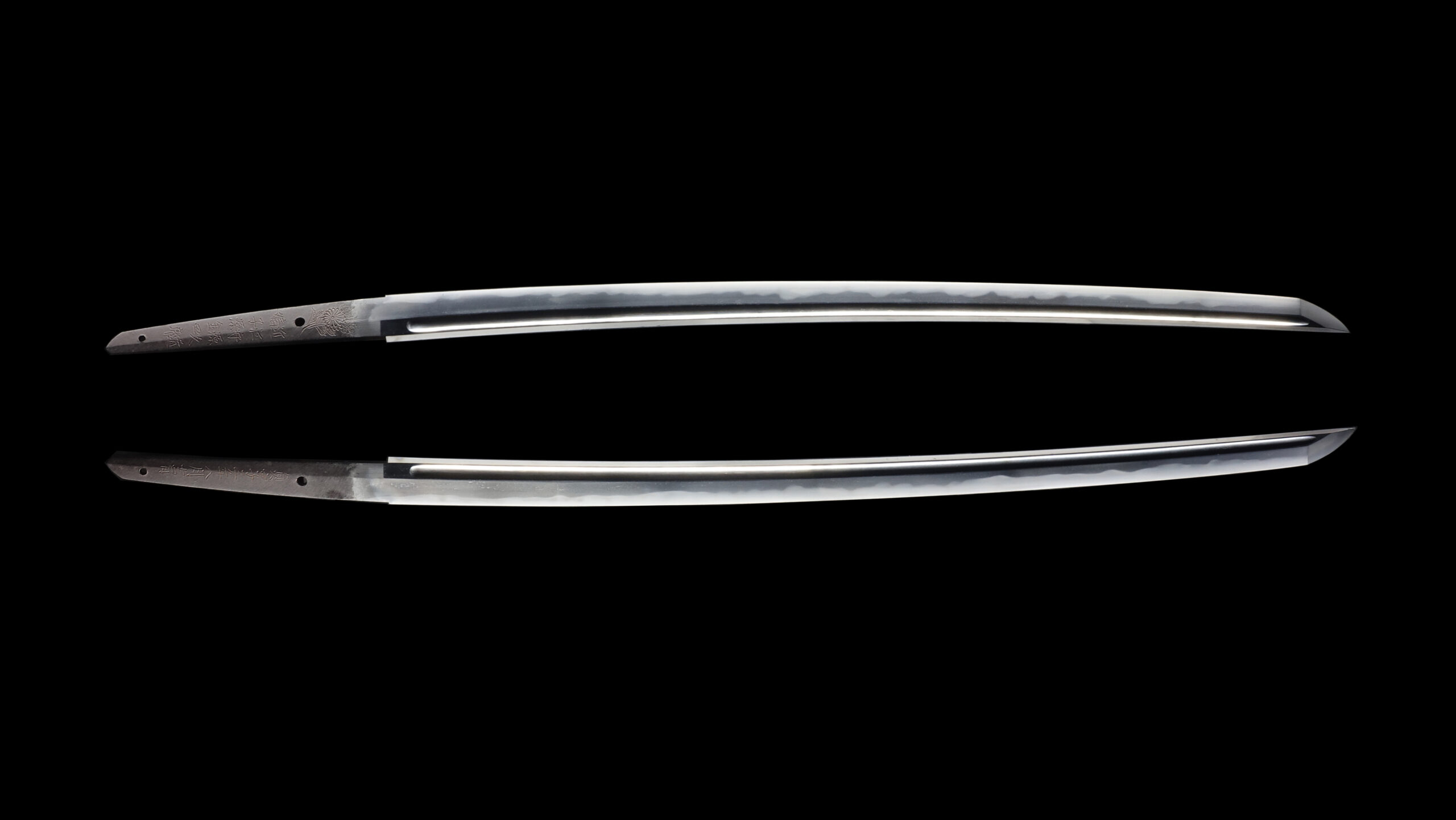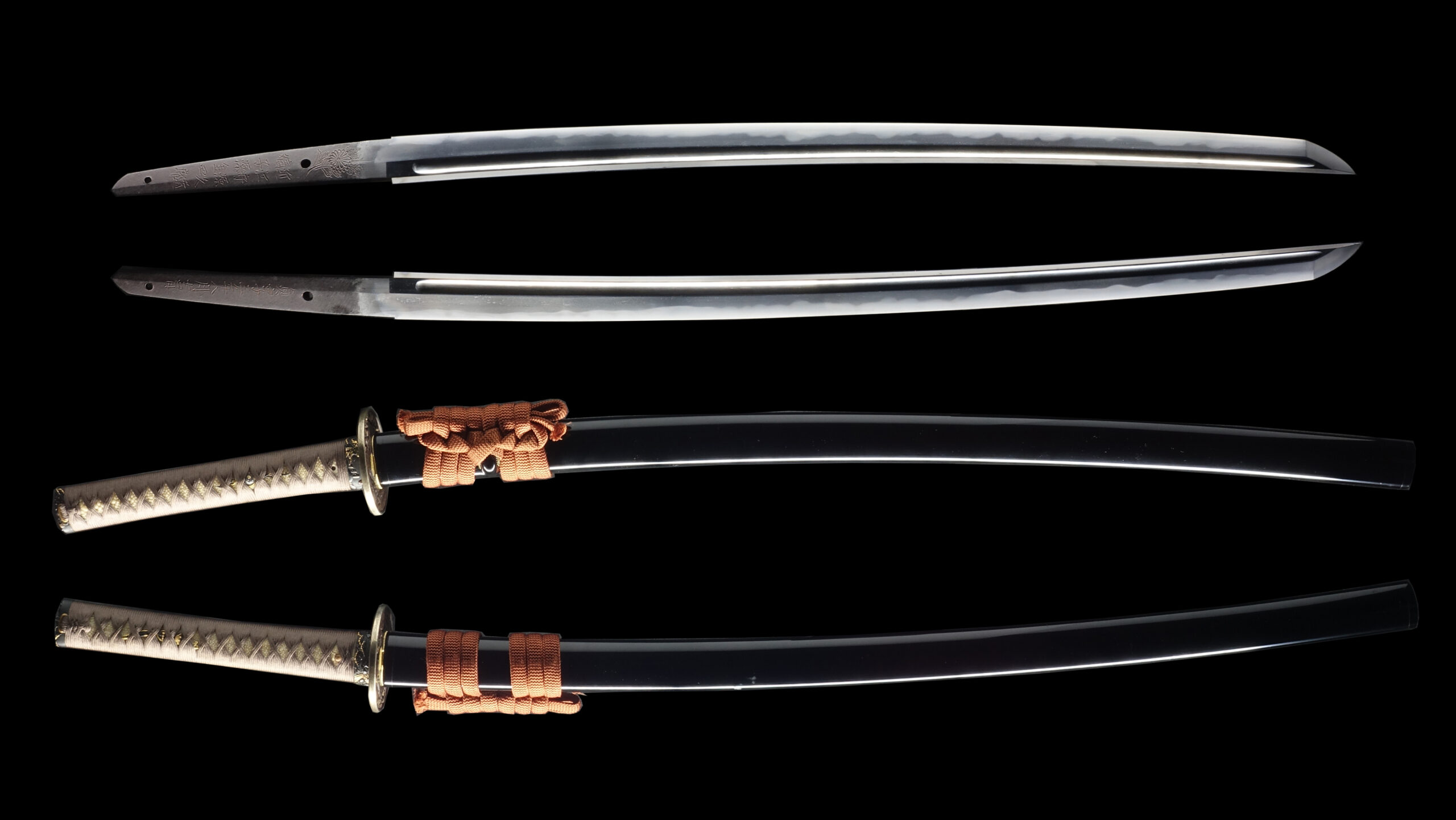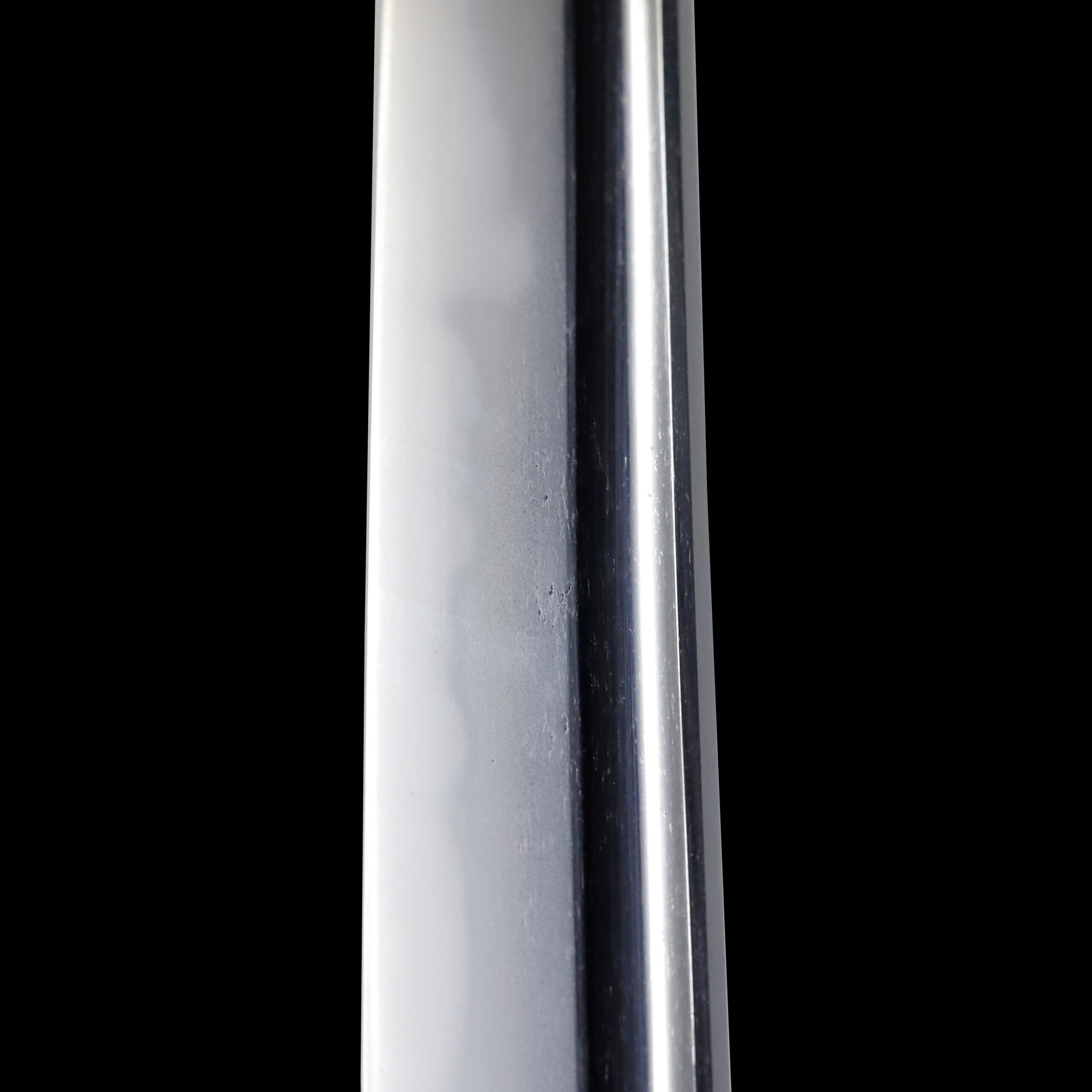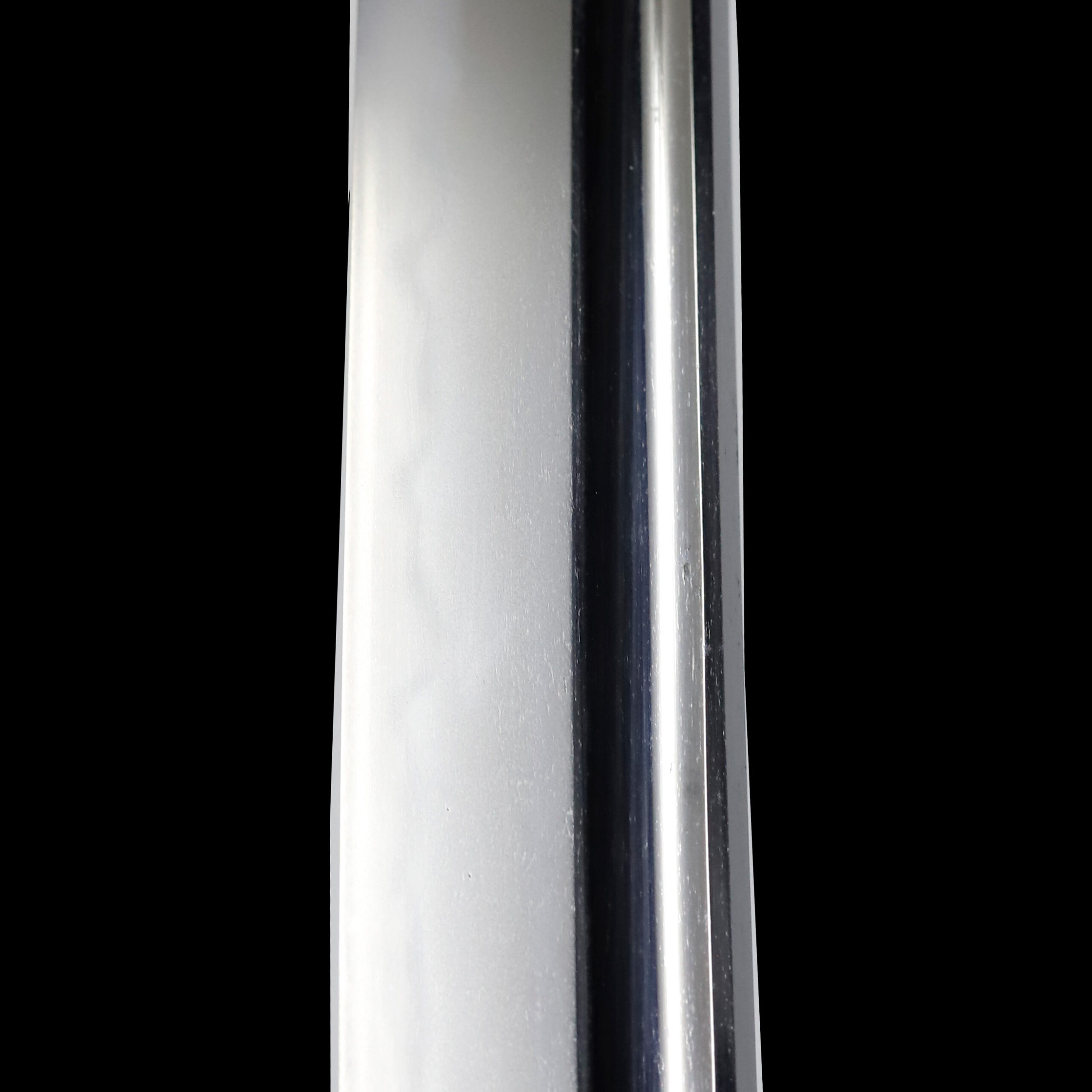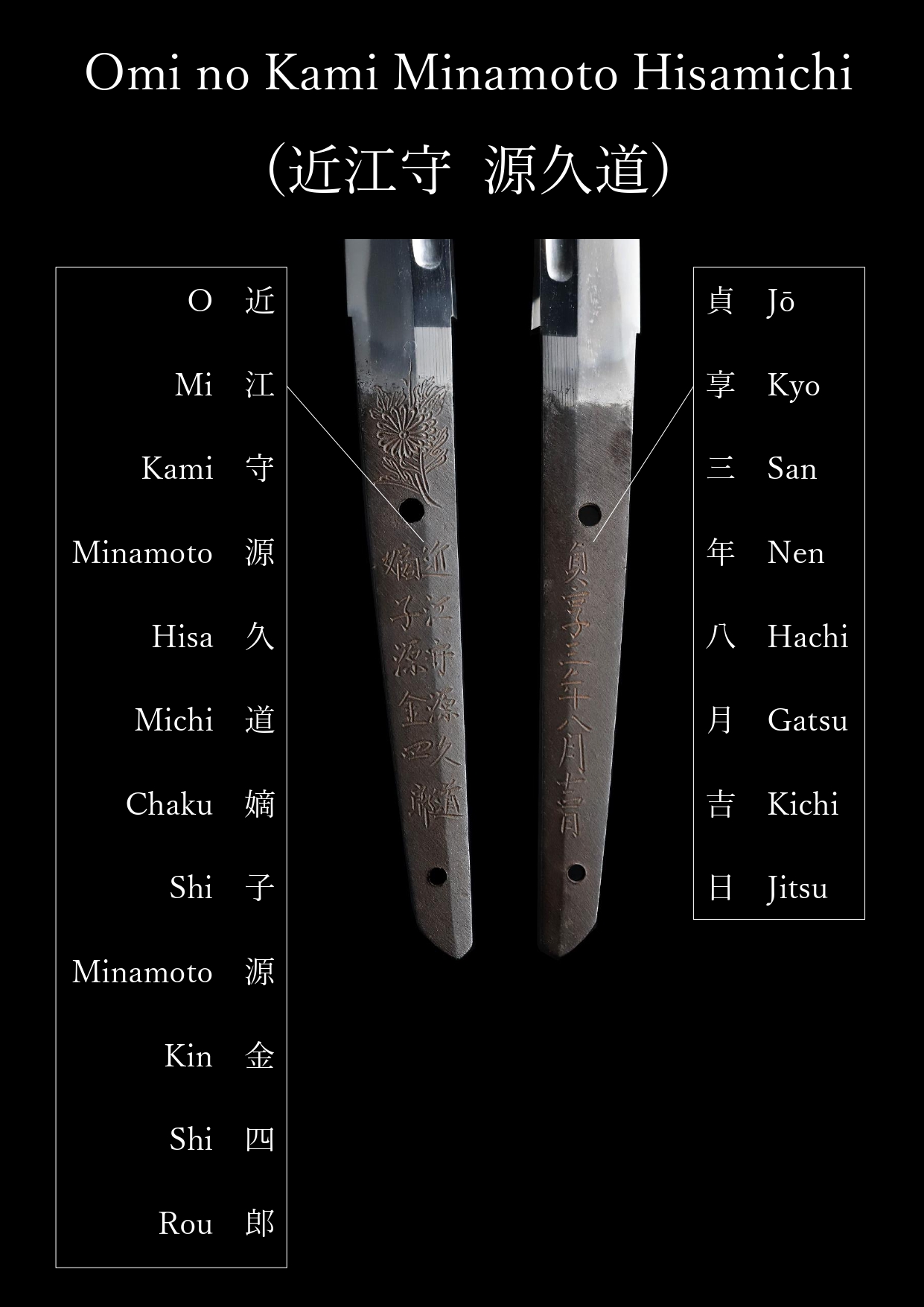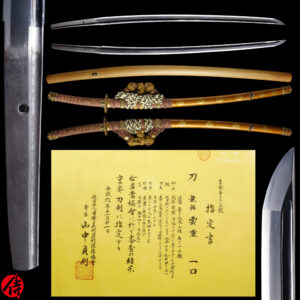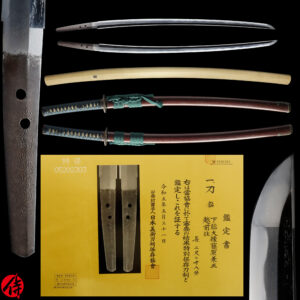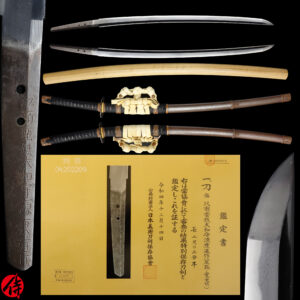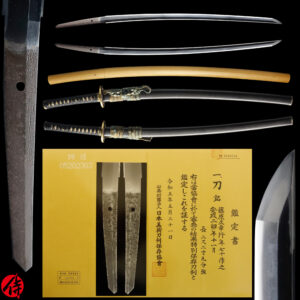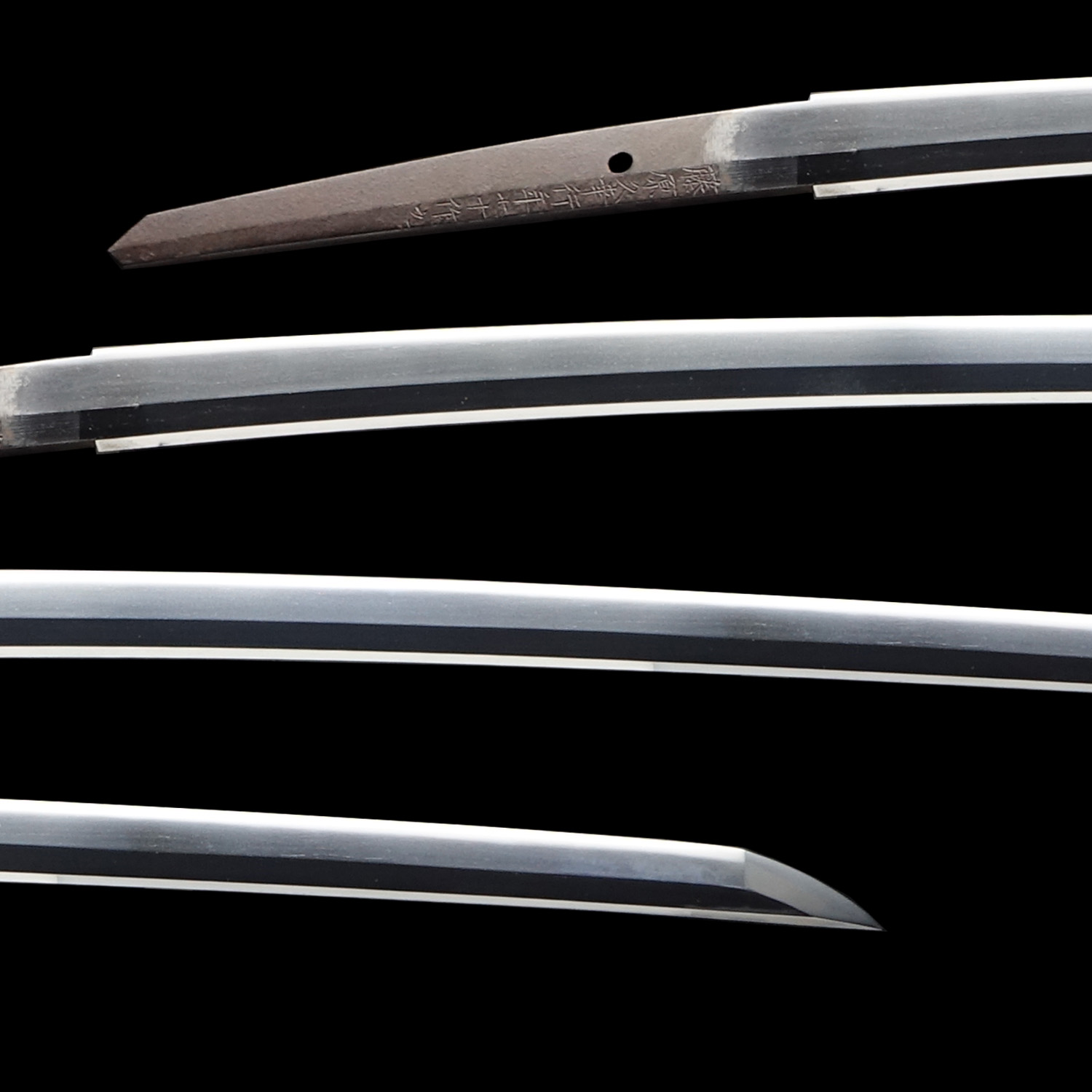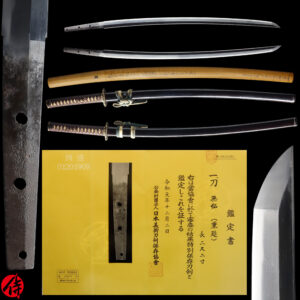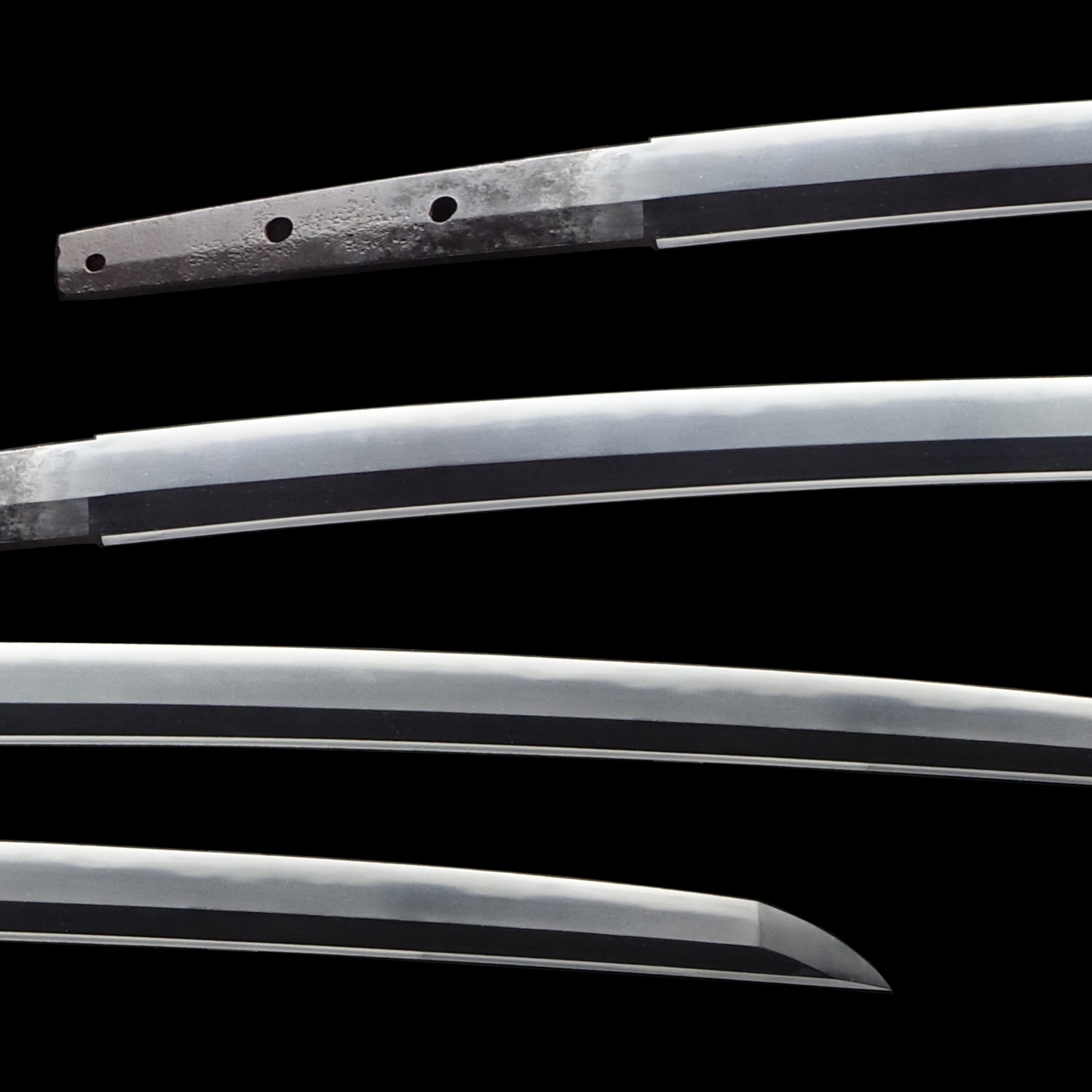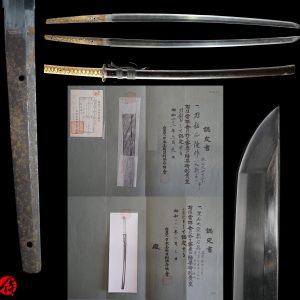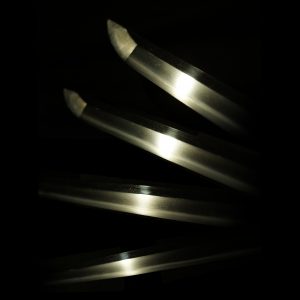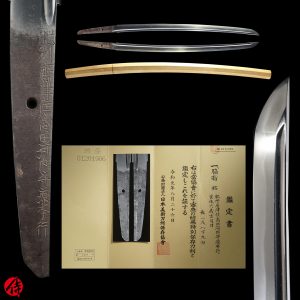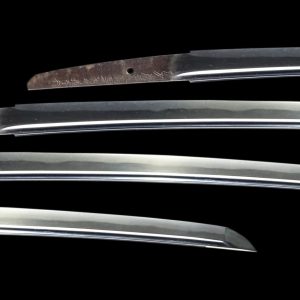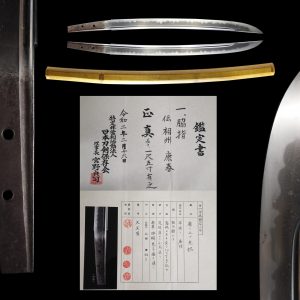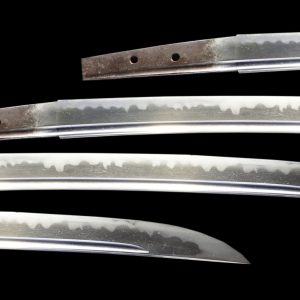Antique Japanese Sword Katana Signed by Omi no Kami Minamoto Hisamichi with Tokubetsu Hozon Certificate
【Description】
This blade was signed by Omi no Kami Minamoto Hisamichi (近江守源久道) in the third year of the Jokyo era (1685). Judging from the year inscribed on the tang, we believed it was made by the second-gen Hisamichi. The swordsmith’s name Hisamichi lasted seventh generations. The second generation was especially active during the early-mid Edo period (1688-1711).
The first-gen Hisamichi, his father, was born in the second year of the Kan-Ei era (1625) in Omi province (Shiga prefecture). He belonged to Mishina school, a prestigious school in Yamashiro province(today’s Kyoto prefecture). He studied sword forging techniques under the master, the second-gen Iganokami Kinmichi (伊賀守金道), one of the most famous swordsmiths in Yamashiro province during the early Edo period.
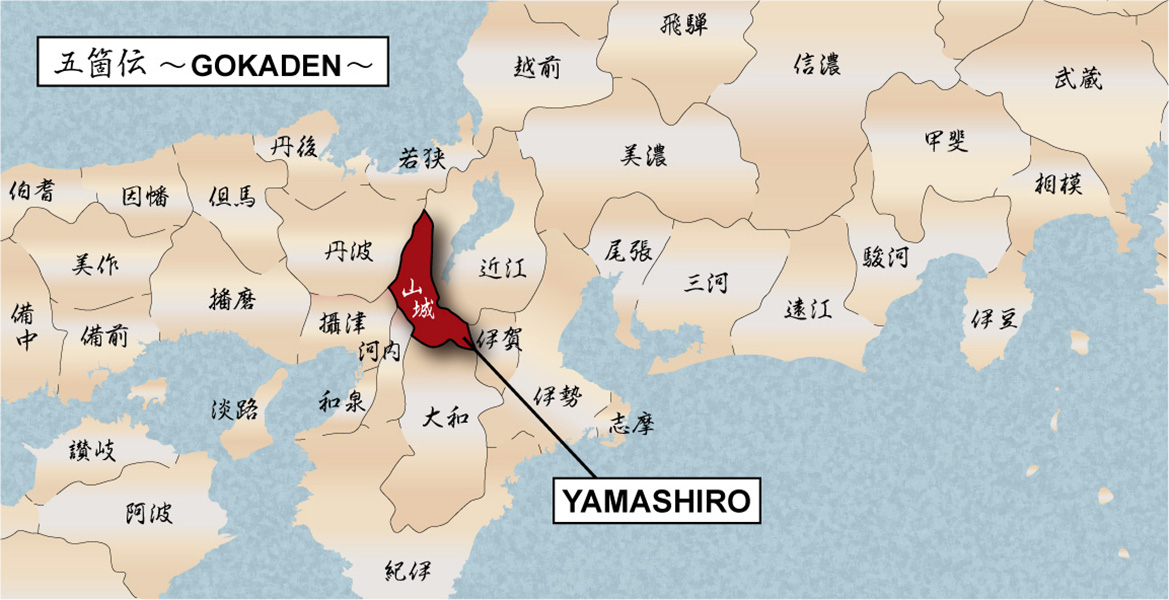
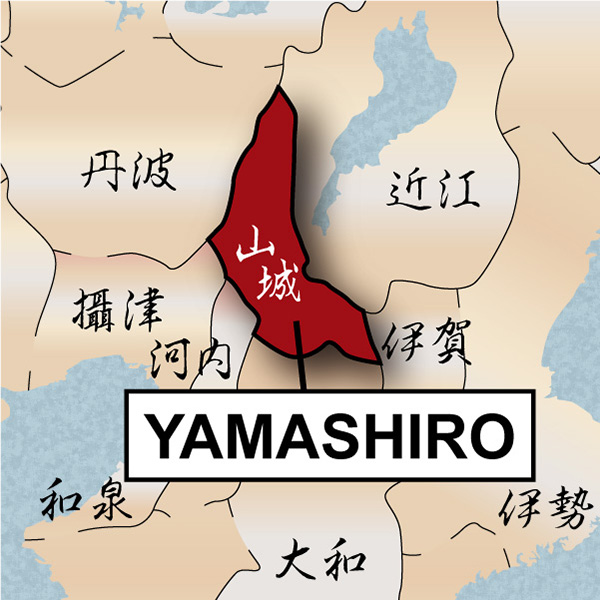
The first-gen Hisamichi received the honorable title of Omi No Kami(近江守) in 1662 when he was 37 years old. The imperial court back then gave the title of Kami to those who were excellent at sword making. After receiving this title, the swordsmith added it to his maker’s name when he signed his swords, such as Omino Kami Hisamichi. The first-gen Hisamichi was also known as one of Gokaji. (five most prestigious swordsmiths in Kyoto). He was allowed to inscribe a chrysanthemum emblem, which is the symbol of the Japanese emperor. His sword forging technique was so great that the emperor permitted him to use this emblem, which was honorable for any swordsmith. The sword forged by him were also famous for their sharpness. He passed his excellent craftsmanship to the second-gen Hisamichi. And, he died at the age of 86 in 1711.
The second Hisamichi was born in the third year of the Kanbun era (1663) as the son of the second-gen Rai Kimichi, who also belonged to Mishina school. He originally signed Hisatsugu (久次). He was eventually adopted by the first-gen Hisamichi and changed his maker’s name to Hisamichi. In the 15th year of the Genroku era, he received Omi no Kami title like his father. In the 7th year of the Kyoho era, the second-gen Hisamichi was ordered to stay in Edo City (Today’s Tokyo) to forge swords. Since the fourth generation, Hisamichi served Date clan in Iyo province and lasted until the early Meiji period.
It is appraised as a Tokubetsu Hozon Touken (特別保存刀剣) issued by NBTHK (Nihon Bijutsu Touken Hozon Kyokai: 日本美術刀剣保存協会). This authentication paper was only given to authentic Japanese swords, especially well preserved and high quality with artistic value.
*Please keep in mind that there are a couple of Kitae Kizu on the Hi (groove on the blade) while they are all minor. If you like to know the detailed condition, please feel free to contact us.
【 Blade】
Cutting Edge Length (Nagasa): 60.2 cm (23.7 inches)
Curvature (Sori): 1.1 cm (0.43 inches)


Hamon:
the crystalline structure which forms along the cutting edge of a blade as a result of the hardening process
Jimon(Jihada):
visible steel surface pattern created by folding and hammering during forging process
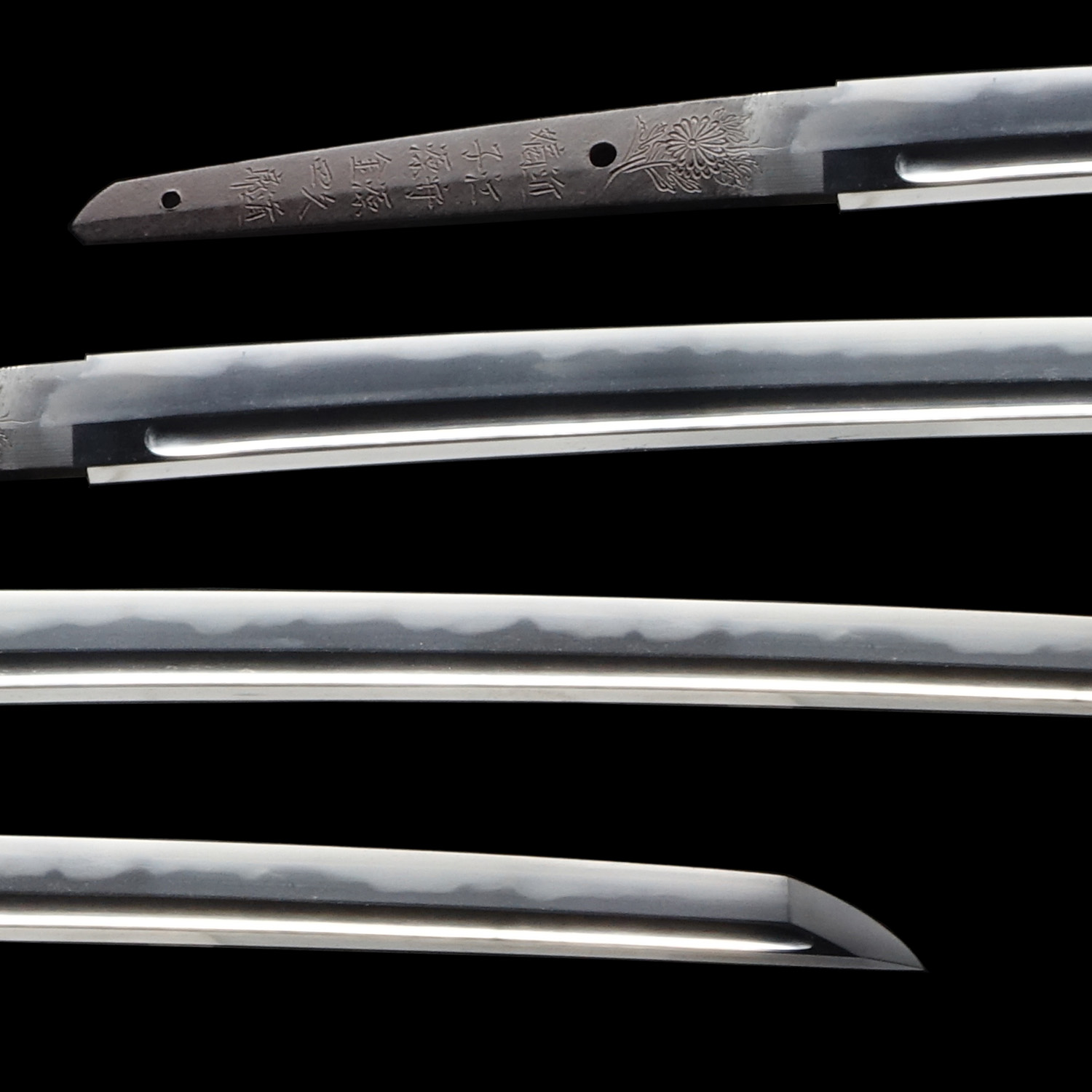
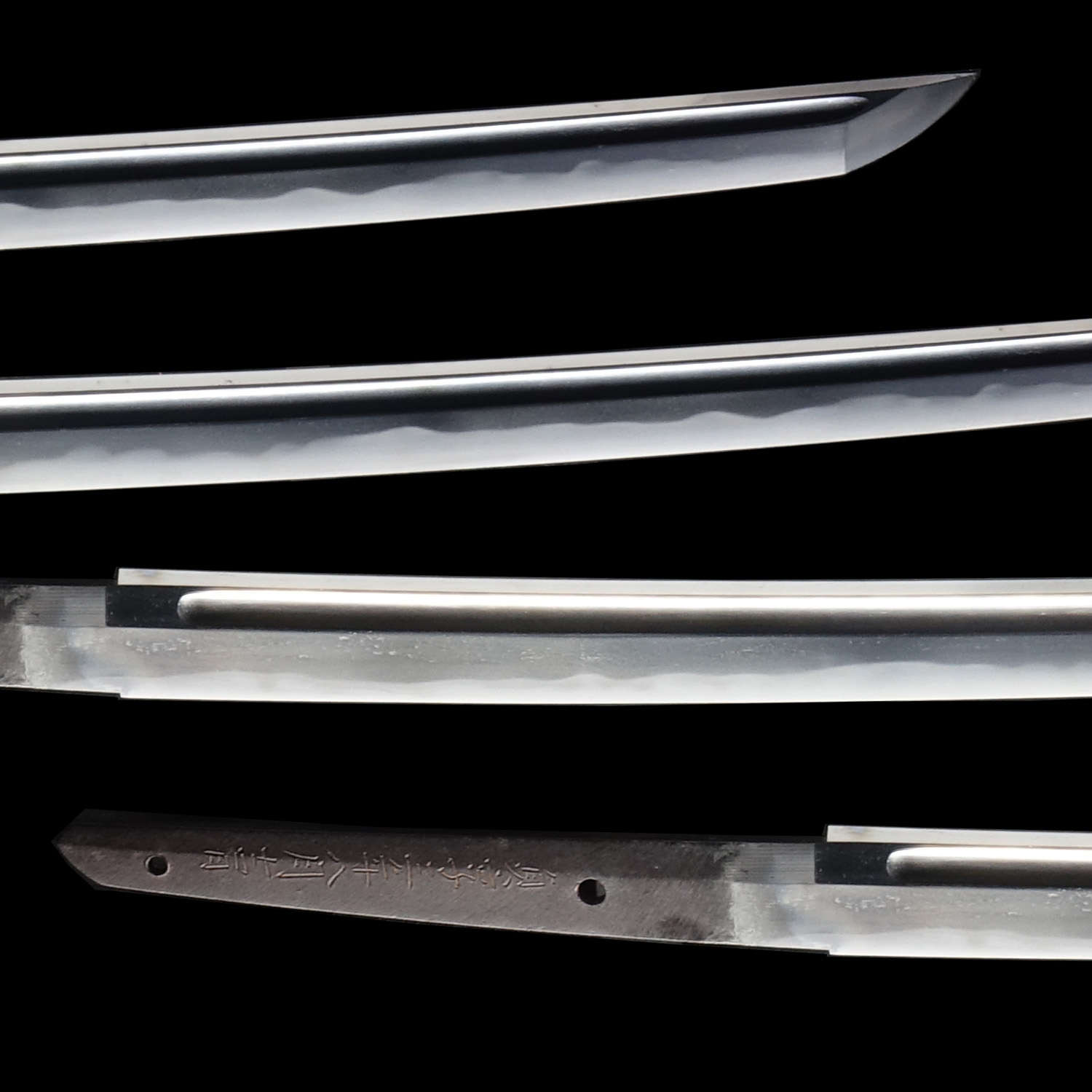
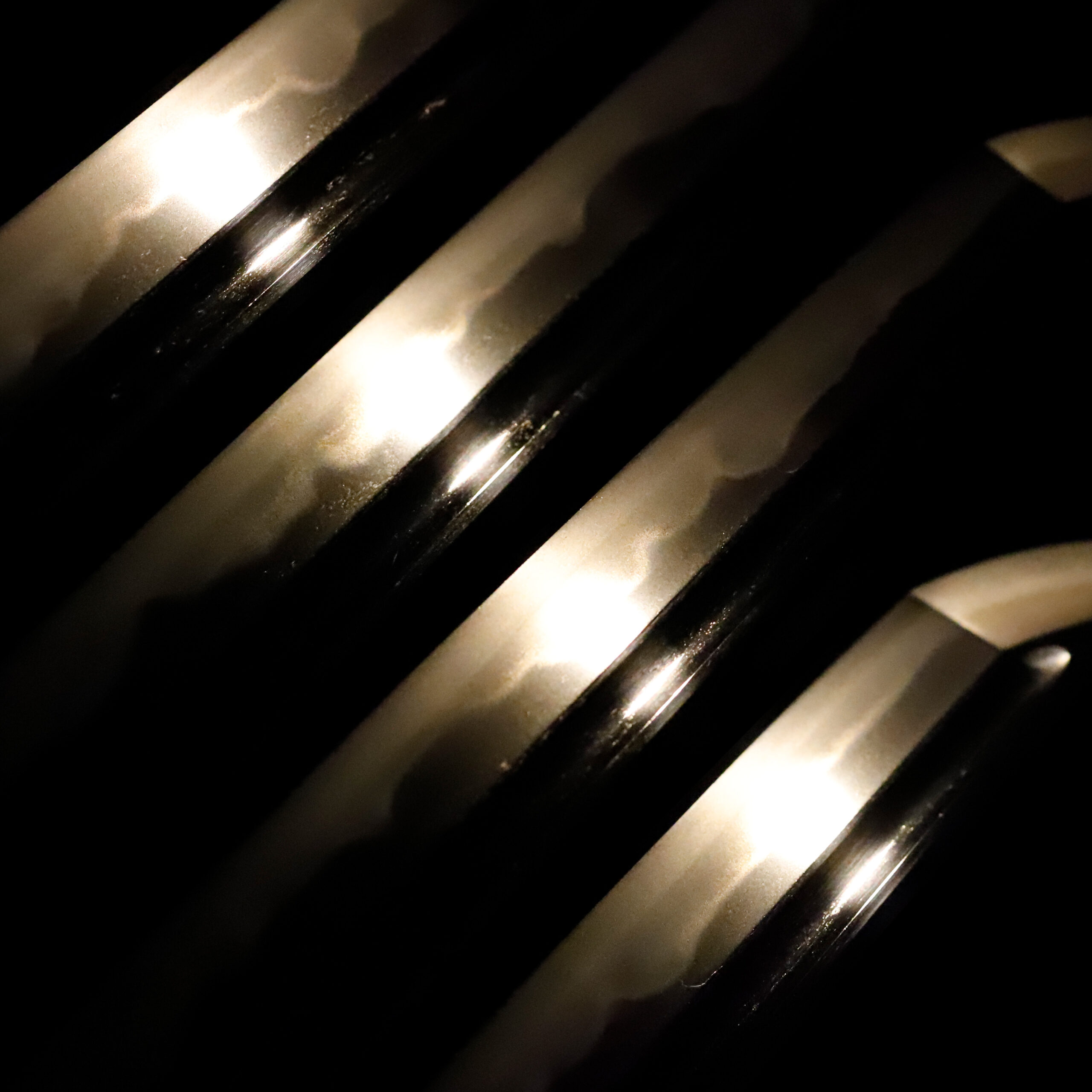
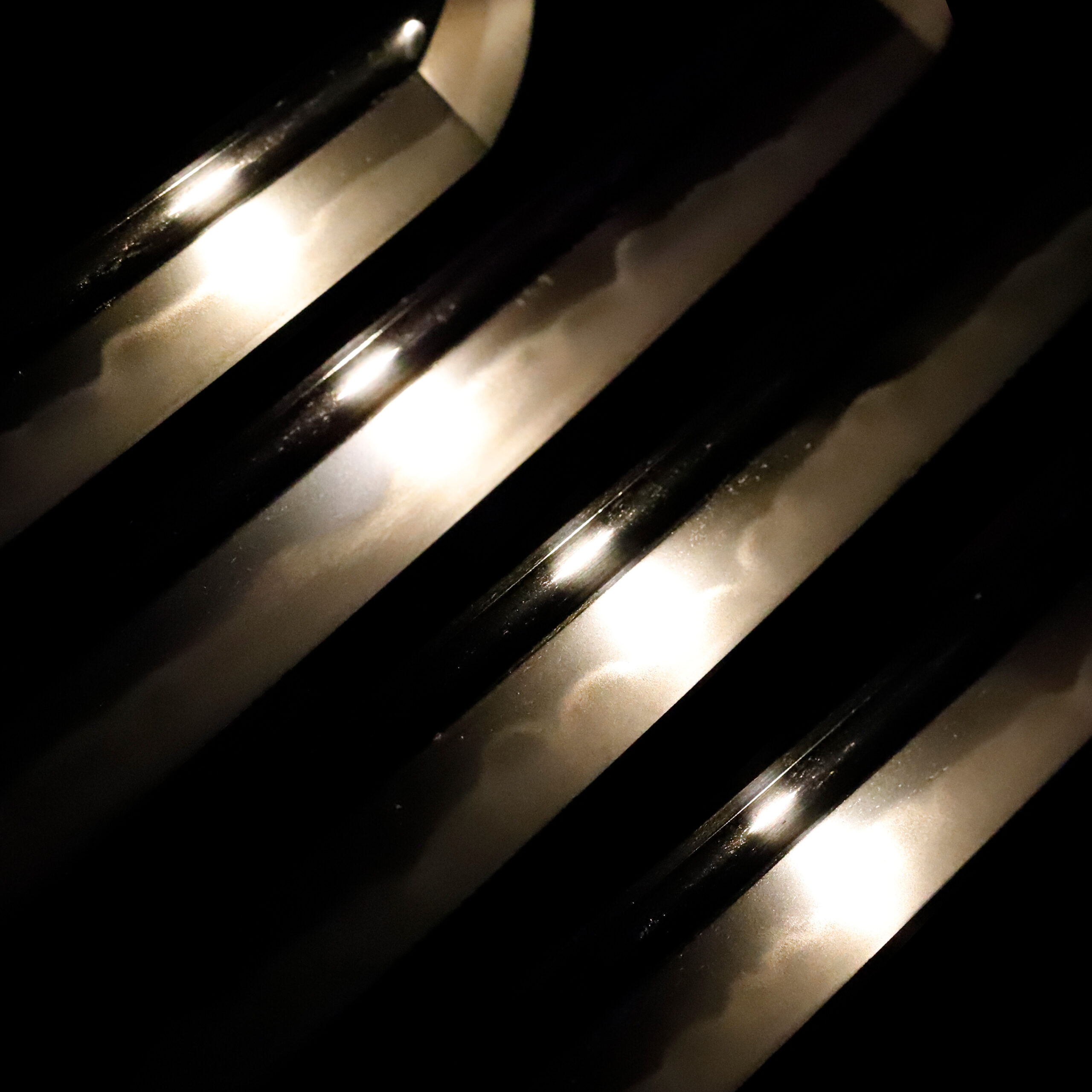
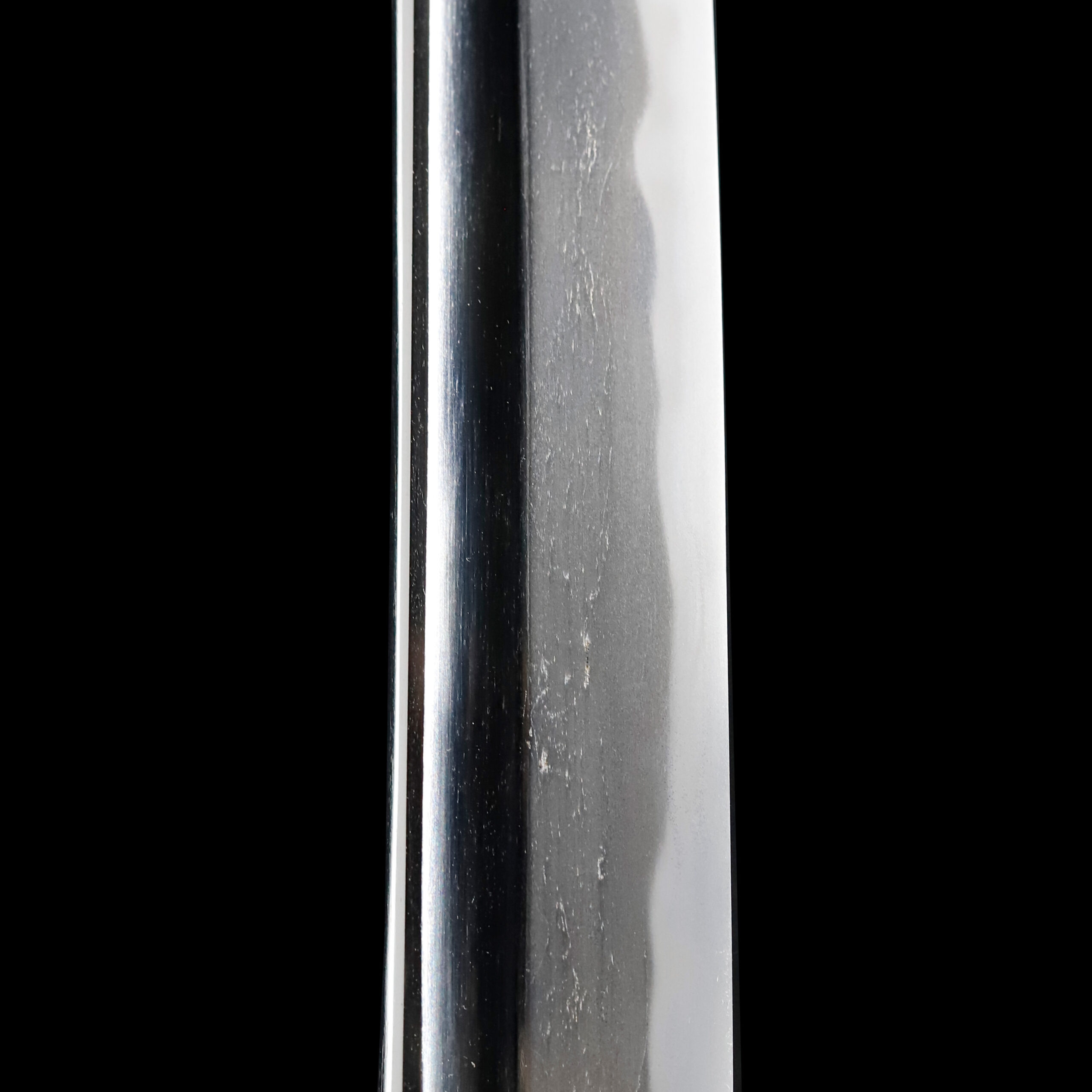
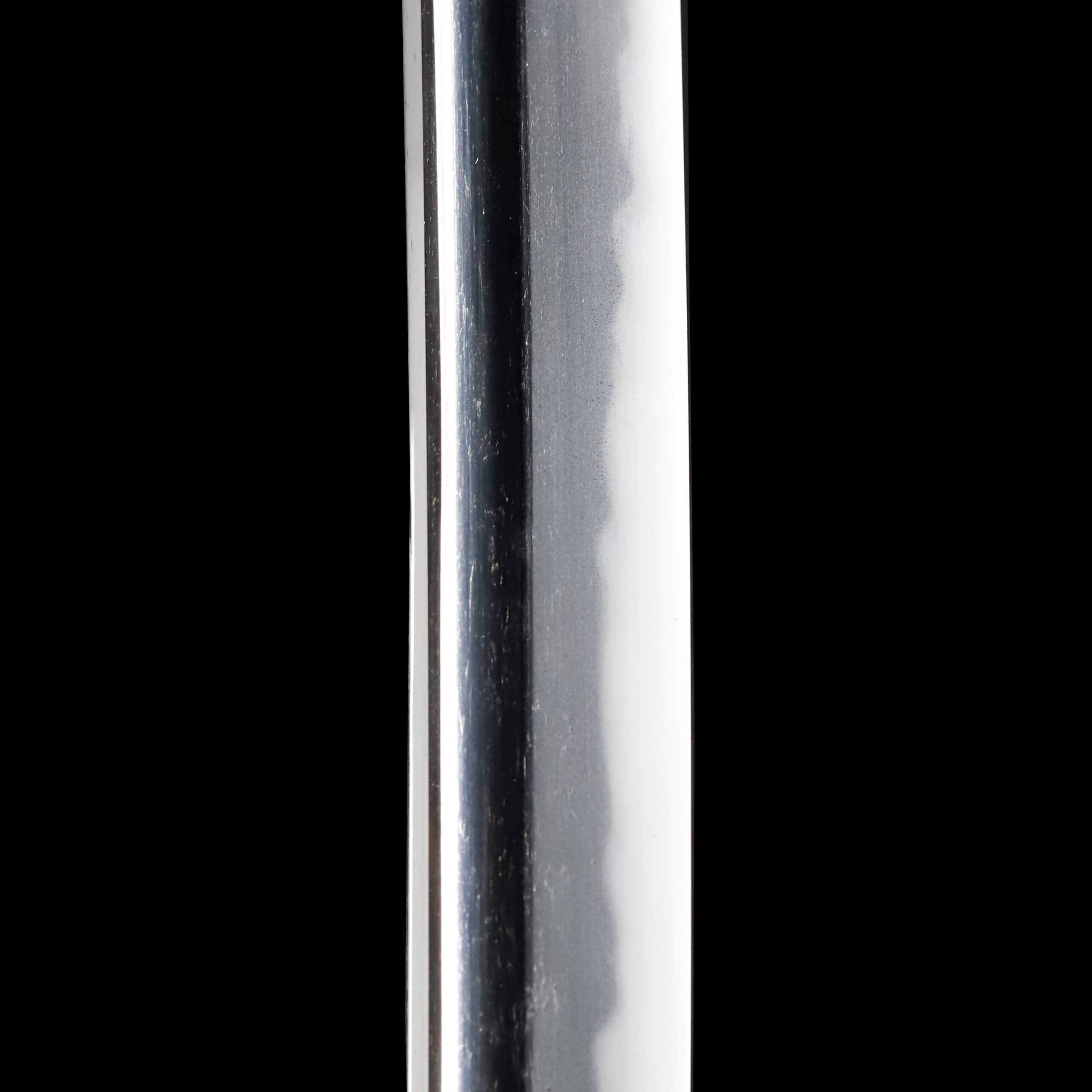
Nakago: Nakago is the tang of the Japanese sword.
Japanese swordsmiths left the black rust on the tang because it prevents red rust while the tang is in its handle. And the discoloration of the tang was created over time, and it is a great indicator for a Japanese sword specialist to estimate when the sword was forged.
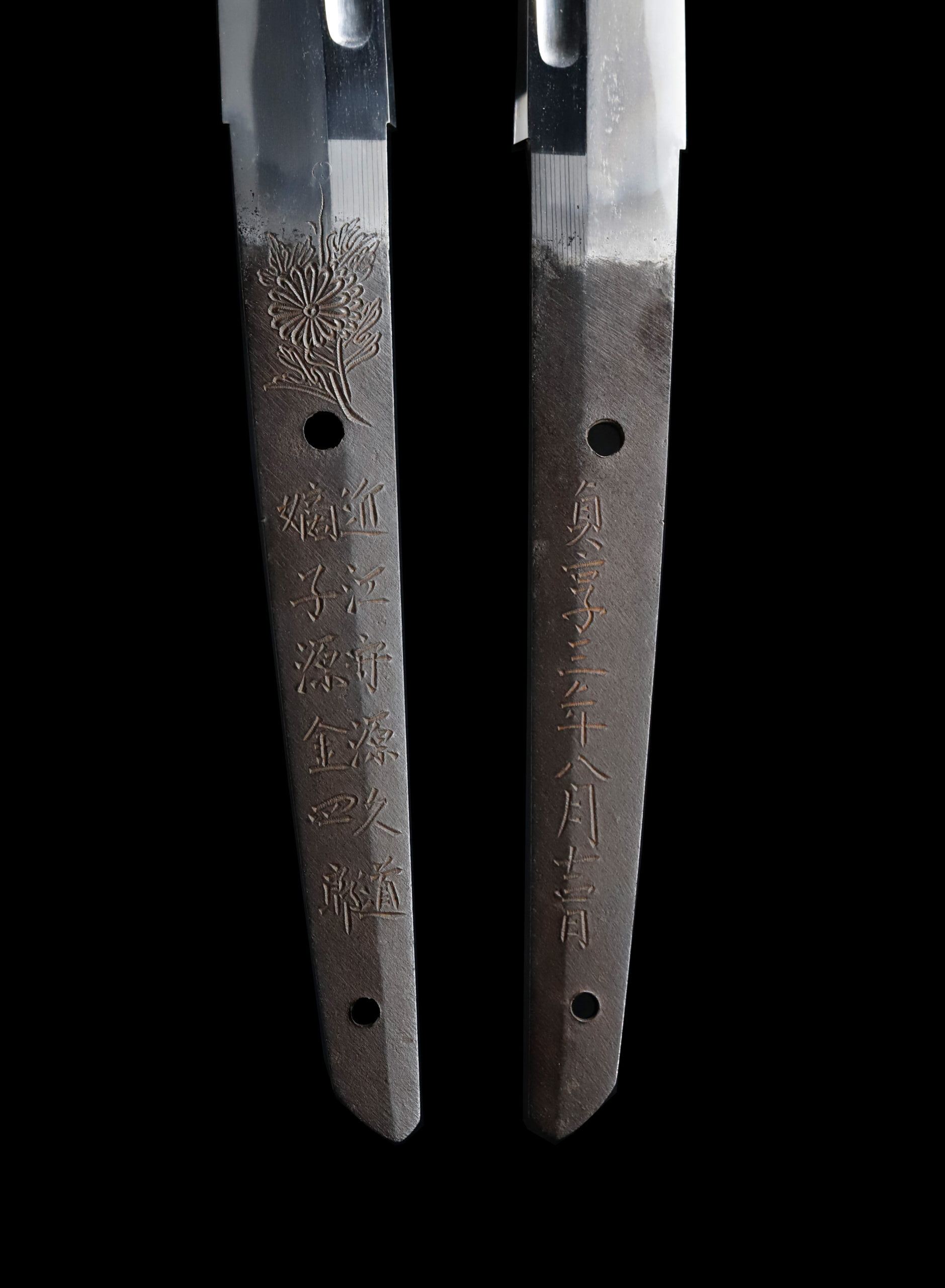
Koshirae: Koshirae is the mounting of the Japanese sword. There are several parts that consist of Koshirae such as Saya (Scabbard), Tsuka (Handle), Tsuba (Handguard).
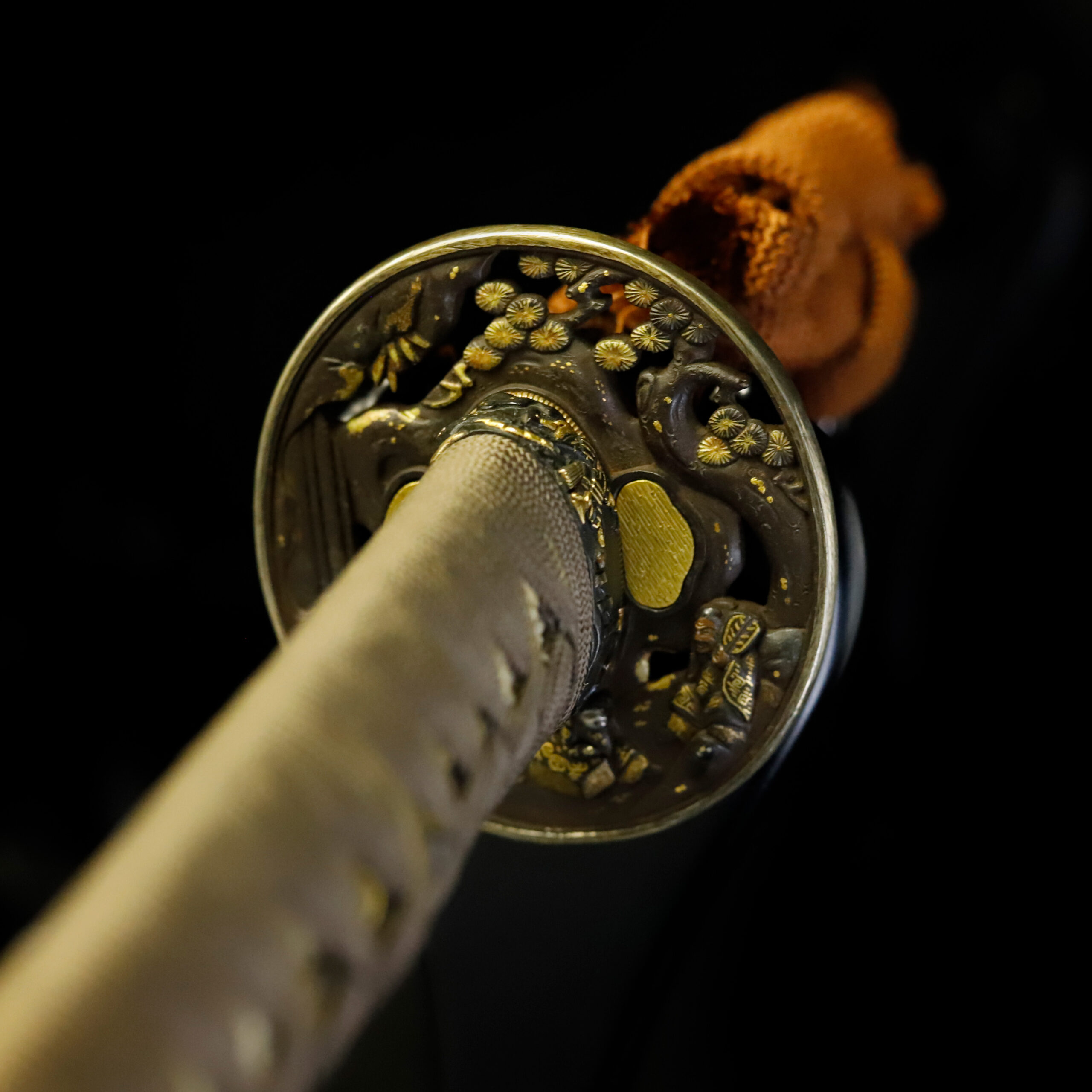
Fuchi-Kashira: A pair of matching sword fittings that cover the upper and bottom parts of its sword hilt.
This Fuchi Kashira’s surface is decorated with the Nanako-Ji (魚子地) technique. This process makes a uniform minimal protrusions pattern by hitting the Nanako-Ji Tagane (魚子地鏨, a chisel for this technique) on a metal surface. This decorative technique is often seen on sword mountings. A landscape depicting a battlefield is engraved on the ground, which has been applied with this technique. Motifs such as Samurai warriors and pine trees are carved semi-dimensionally, giving it an impressive appearance. Golden coloring is used throughout, adding a touch of elegance to this work. Including other sword mountings that we will explain later, this Katana’s Koshirae is composed of Samurai-related designed metal fittings.
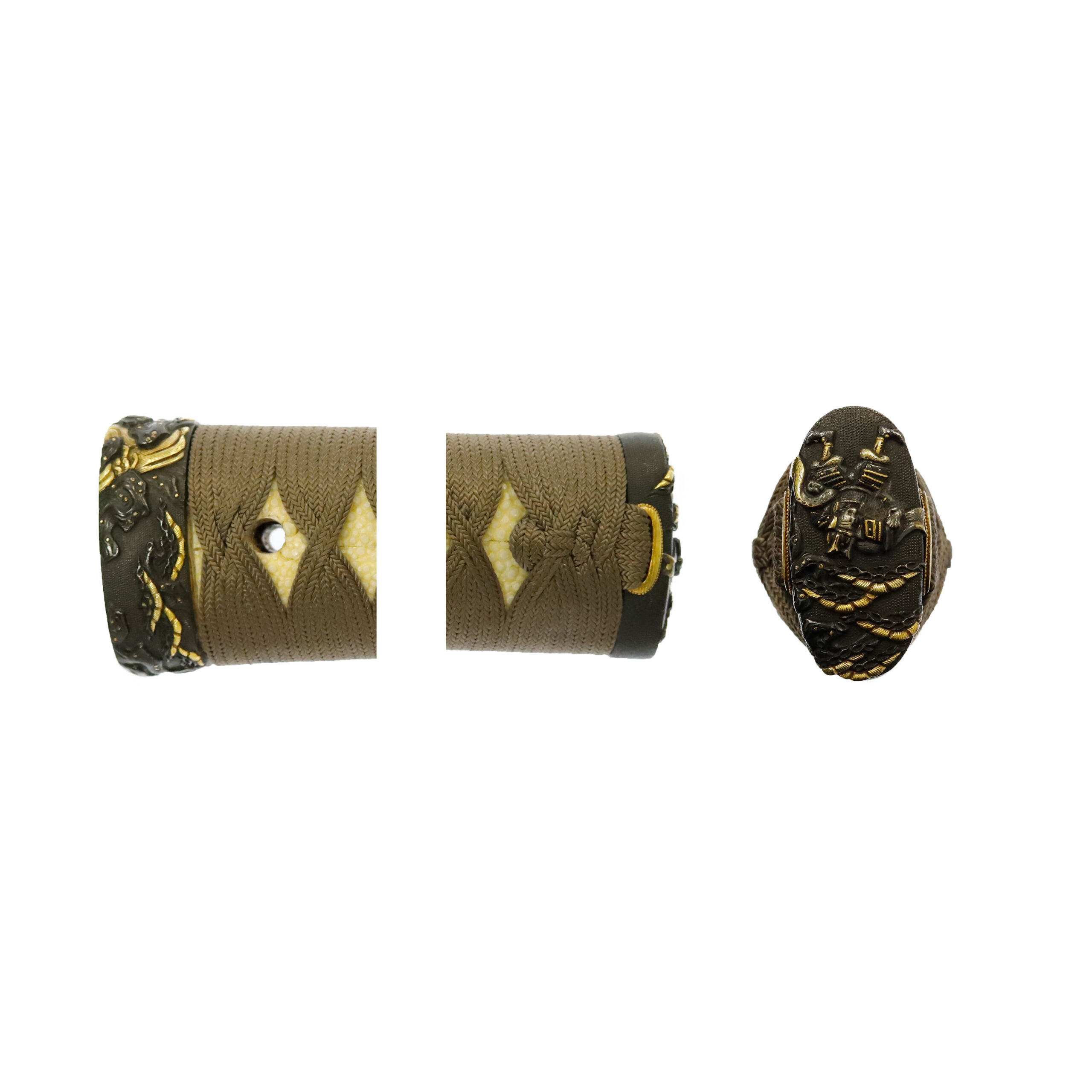
Tsuka and Menuki: Tsuka is the handle of the Japanese sword and Menuki is its decoration.
The upper Menuki is composed of a combination of Kabuto (兜, Samurai helmet) and a bow. A Kabuto is a protector for the head. When people started using Kabutos, it was initially designed for practical use. However, the principal purpose of its design has changed with time; Samurai warriors tried to express their dignity, personality, or religion by wearing the characteristic designed Kabutos. The type of the Kabuto designed on this Menuki is the Suji Kabuto (筋兜). Its form slides sword attacks when weapons hit the Kabuto. It is said that the production of the Suji Kabuto prospered in the Muromachi period.
The bow and arrows were once primary weapons for Samurai before the guns were introduced. With the other side Menuki’s motif (Samurai sword), this Meuki’s design incorporates items worn by warriors on their way to the battlefield, making it a design befitting a Samurai.
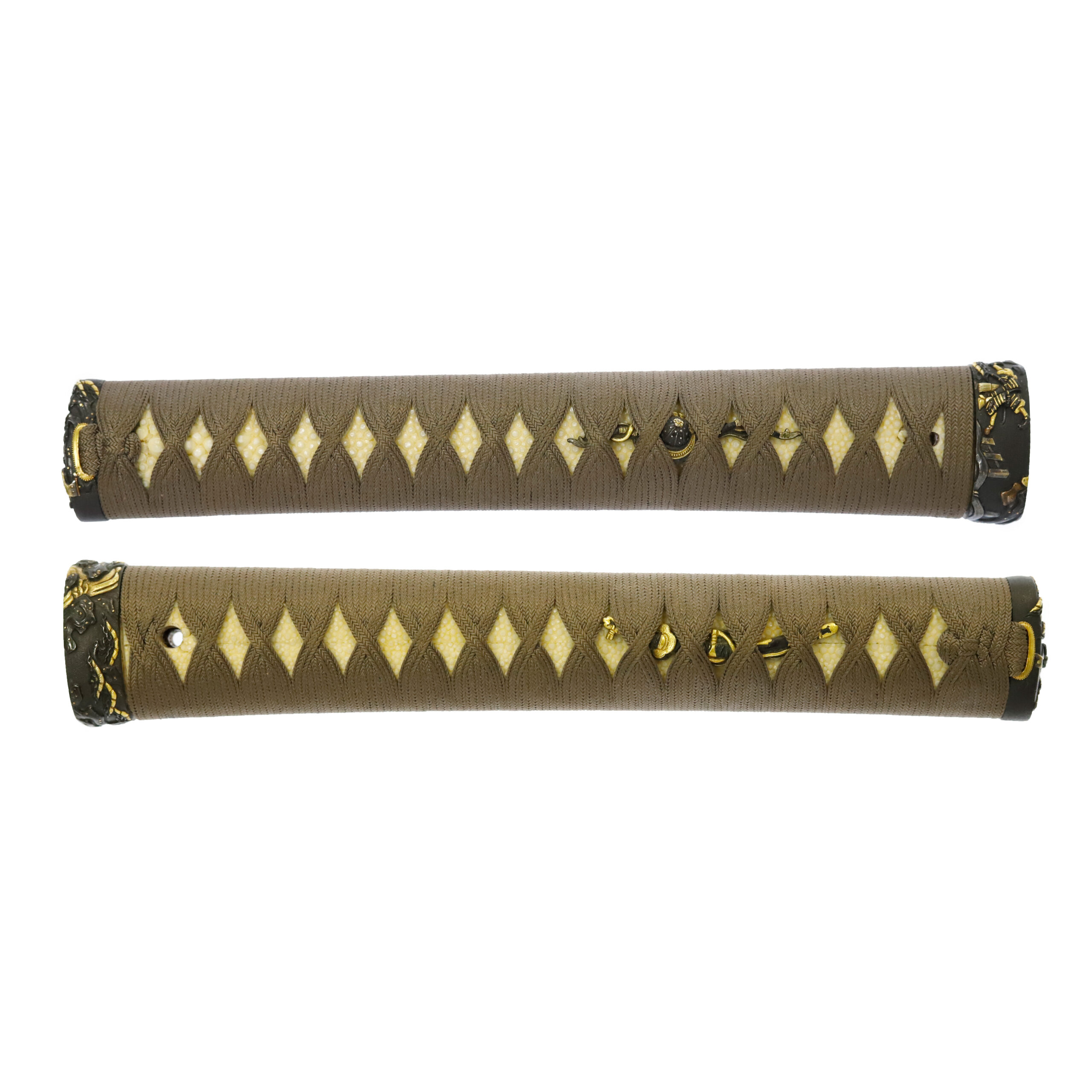
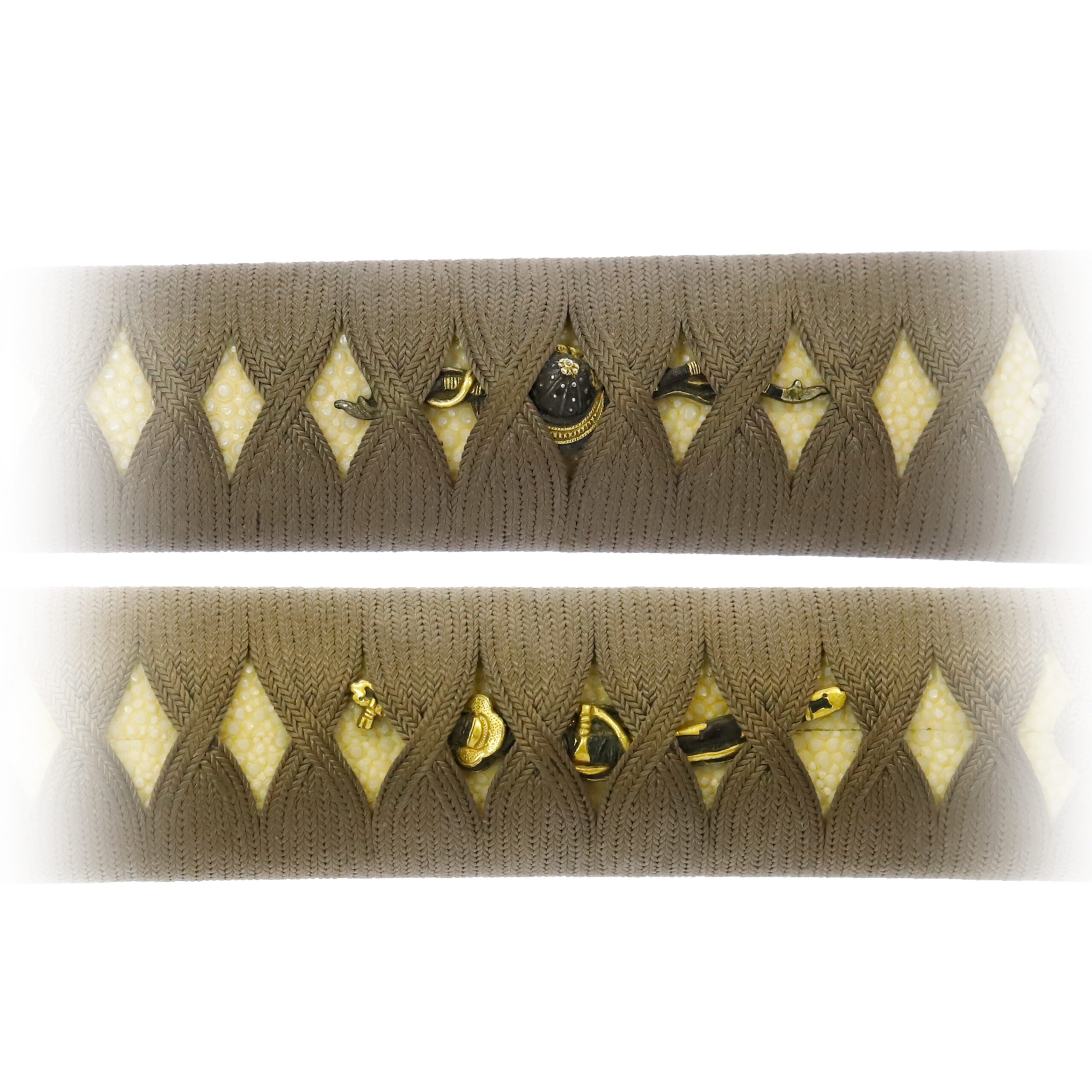
Tsuba and Habaki: Tsuba is the handguard for the Japanese Sword and Habaki is the equipment to make the blade not touch its scabbard inside. It prevents the blade from getting rusty and chipped.
This Tsuba’s Mimi (耳, edge of a Tsuba) is framed with a thin golden metal plate. This decorative process is called the Fukurin (覆輪), and one of its purposes is to add beauty to works. In addition, it has practicality, such as preventing the wear of the edge part. Also, it prevents wear and tear on the Kimono (着物, traditional Japanese cloth) if the edge of a Tsuba damages it by touching the fabric.
If you focus on the center part of this Tsuba, you would find there is a Mei (銘, engraved inscription). Please note that there is no confirmation about this Mei and its metalworker. It is written as follows: 彦根住 光義作 (Hikone-Ju, Mitsuyoshi made). He was active during the middle of the Edo period, and he is considered to be Mogarashi Souten (藻柄子 宗典)’s disciple. Souten lived in Hikone (彦根) area, Oumi-no Kuni (近江国, today’s Shiga prefecture). He was good at the Takabori Iroe (高彫色絵) technique and originated the Hikone-Bori (彦根彫) style. He trained many disciples and played an active role in his longevity over 75 years old. The second Souten was the first’s son. He followed the first’s designs and created lots of excellent Tsubas. It is said that lots of fake Souten Tsubas were made; it shows his works were highly appreciated. This Tsuba might have been made in such a trend.
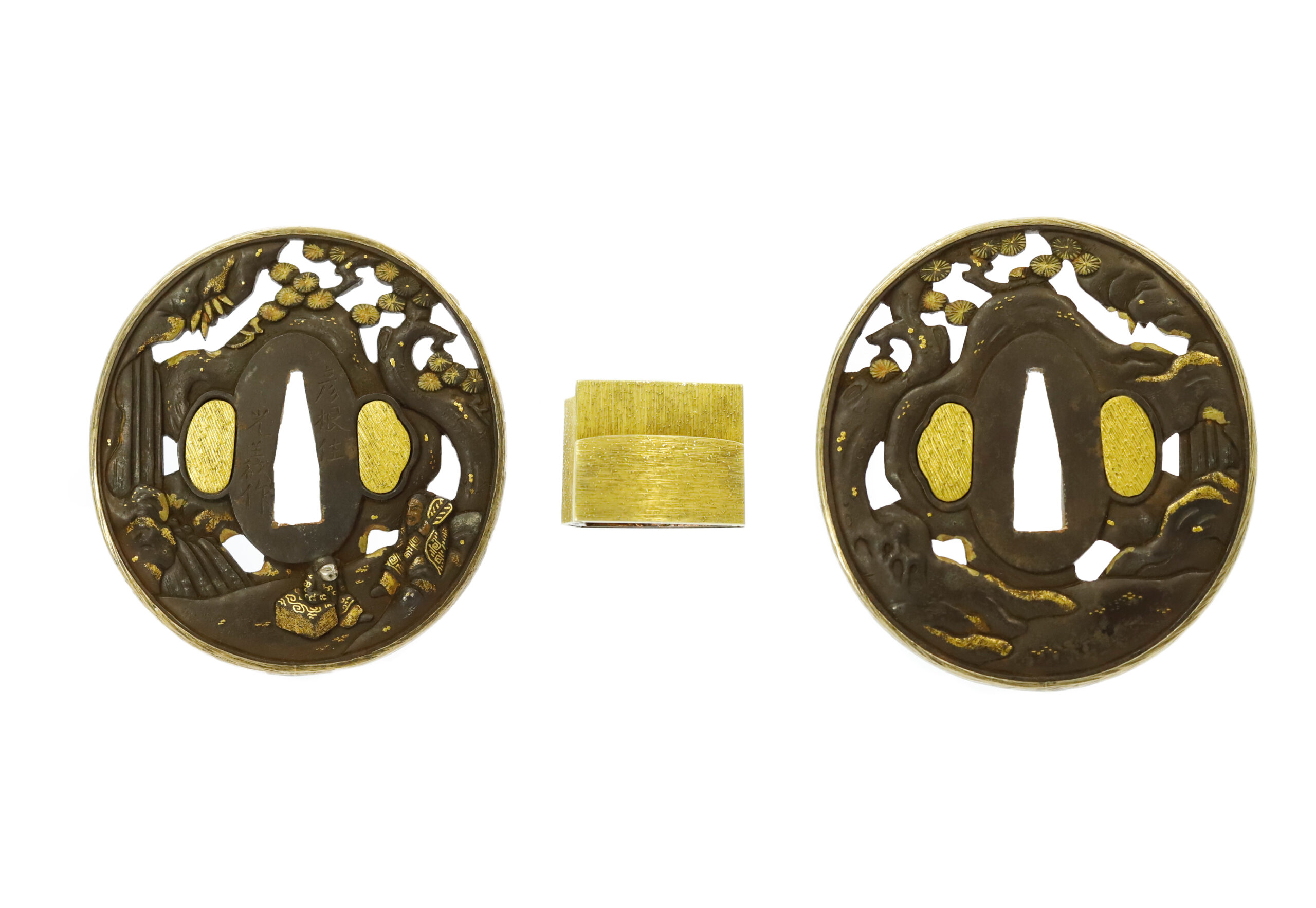
Saya: Saya is the scabbard for the Japanese sword.
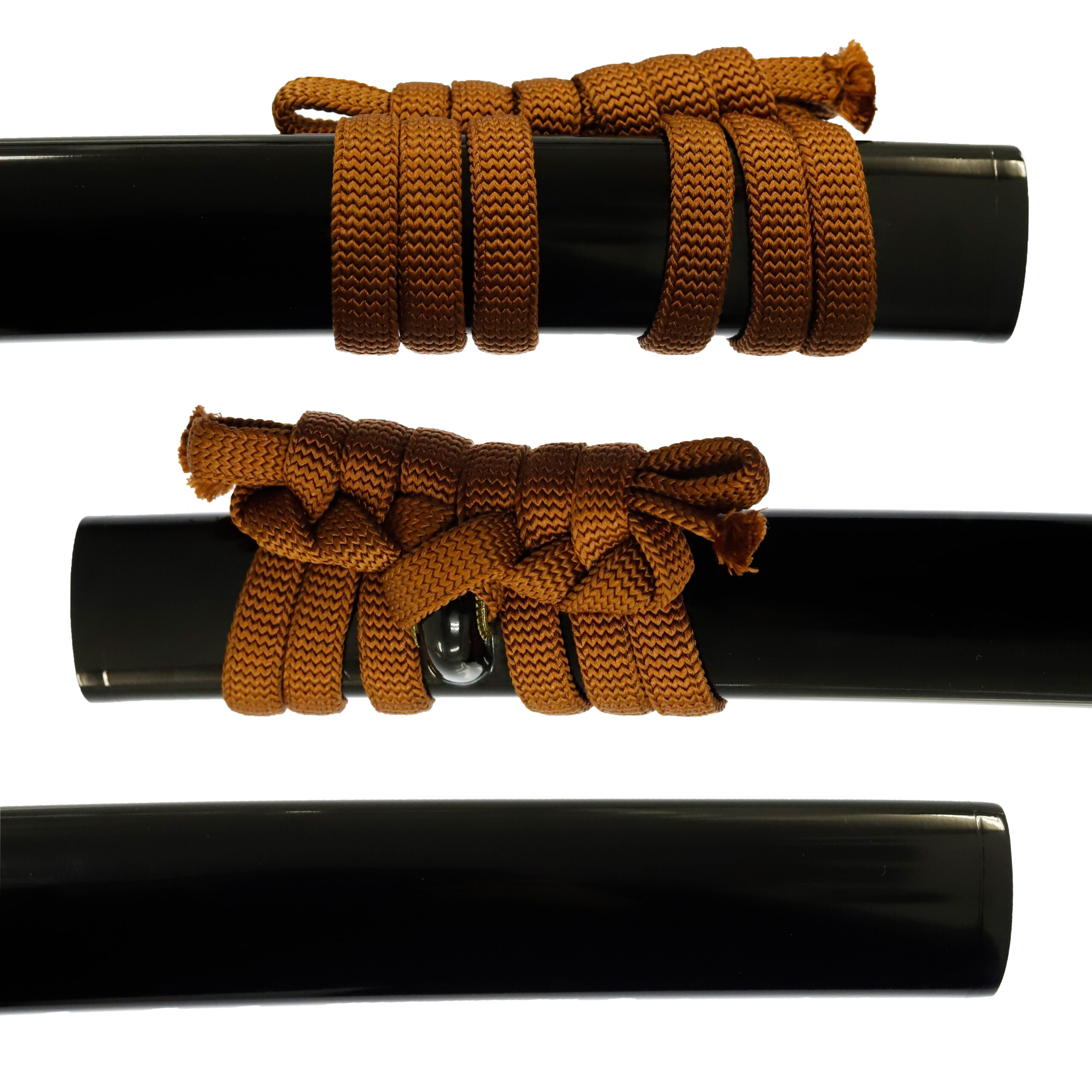
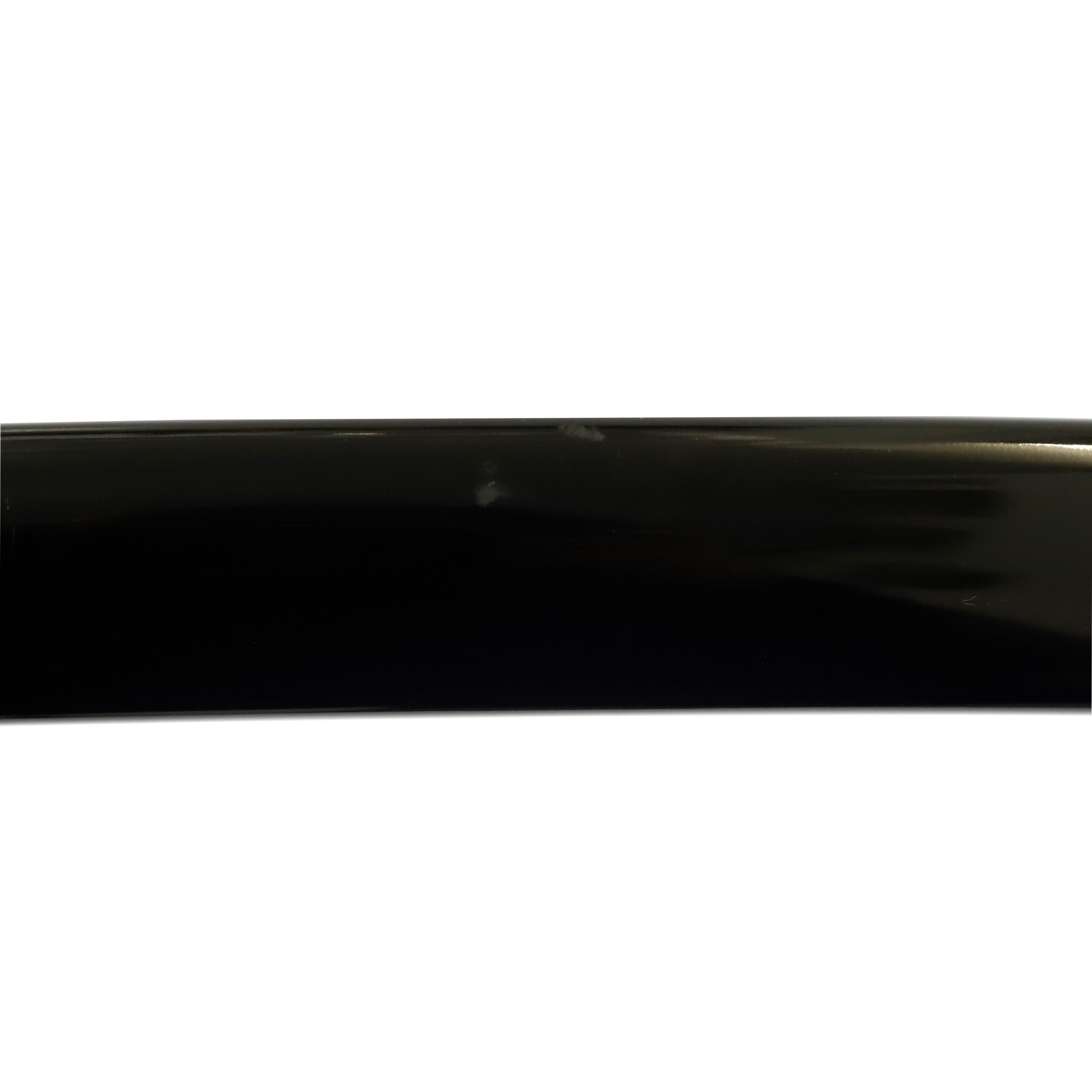
Authentication Paper: NBTHK TOKUBETSU Hozon Certificate for the blade (No. 1017667)
NBTHK, also known as Nihon Bijutsu Touken Hozon Kyokai (the Society for the Preservation of the Japan Art Sword), is one of the oldest Japanese sword appraising organizations in modern-day Japan. They authenticated the blade on March 2nd in the 4th year of Reiwa (2022). They appraised it as Tokubetsu Hozon Touken, the blade especially worth preserving for Japanese society. The purchaser will receive this original certificate as well. We can also translate what is written into English and make a PDF file for your record if you request.
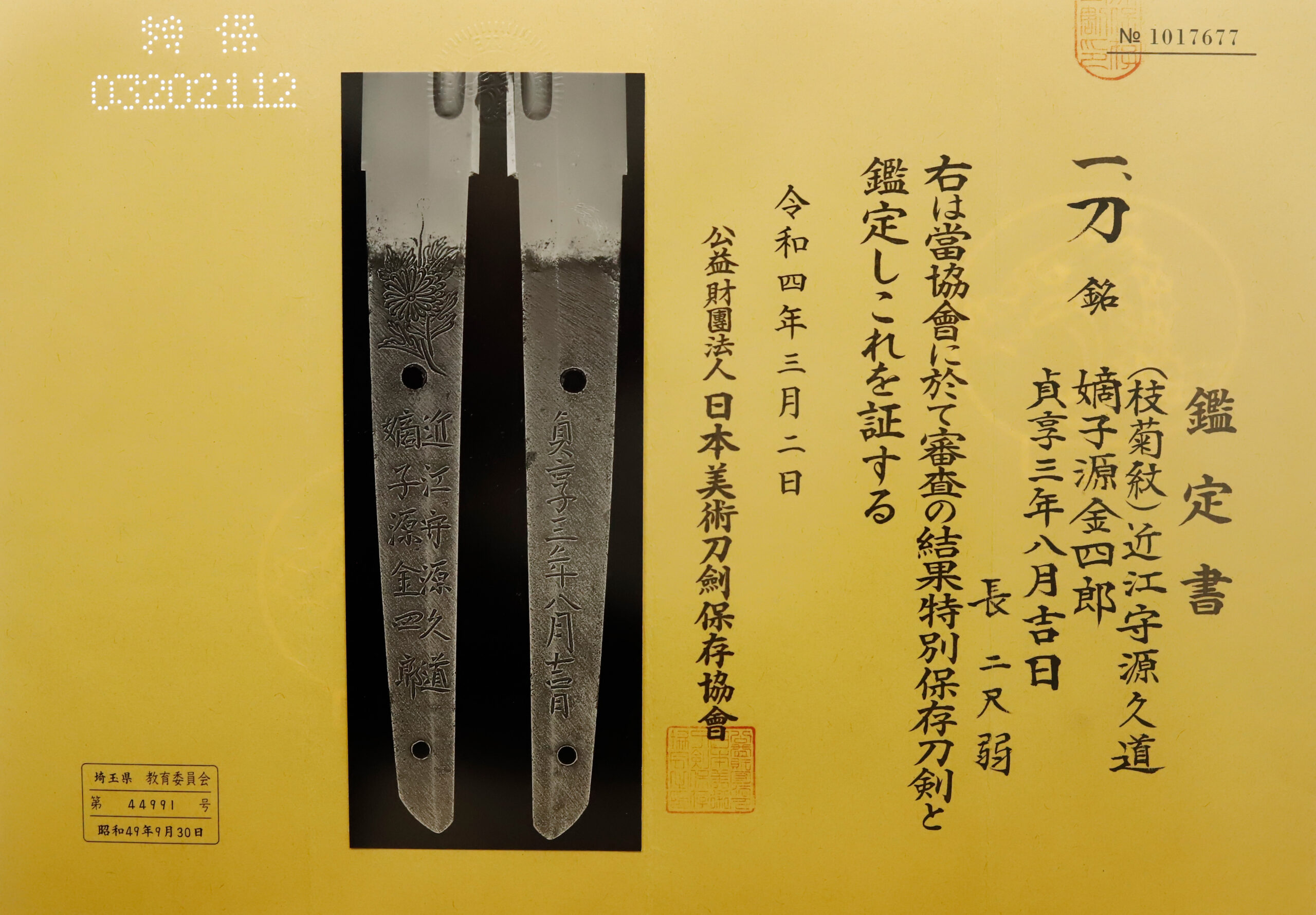
Registration Number: Saitama 44991
The Board of Education in Saitama prefecture issued a registration paper for this sword . It is called Jyu Hou Token Rui Tourokusho (銃砲刀剣類登録証). Bunkacho (The Agency for Cultural Affairs) acknowledges a Japanese sword with this paper as a work of art.
The sword needs to be traditionally hand-forged and made of Tamahagane carbon steel to be registered in the system. With this paper, its owner in Japan can legally own an authentic Japanese sword. Based on this registration number, we will apply for its export permit.
This paper will need to be returned to the board of education when the sword is being shipped abroad, but you can receive a copy of it. An English translation of this registration paper is available on request.
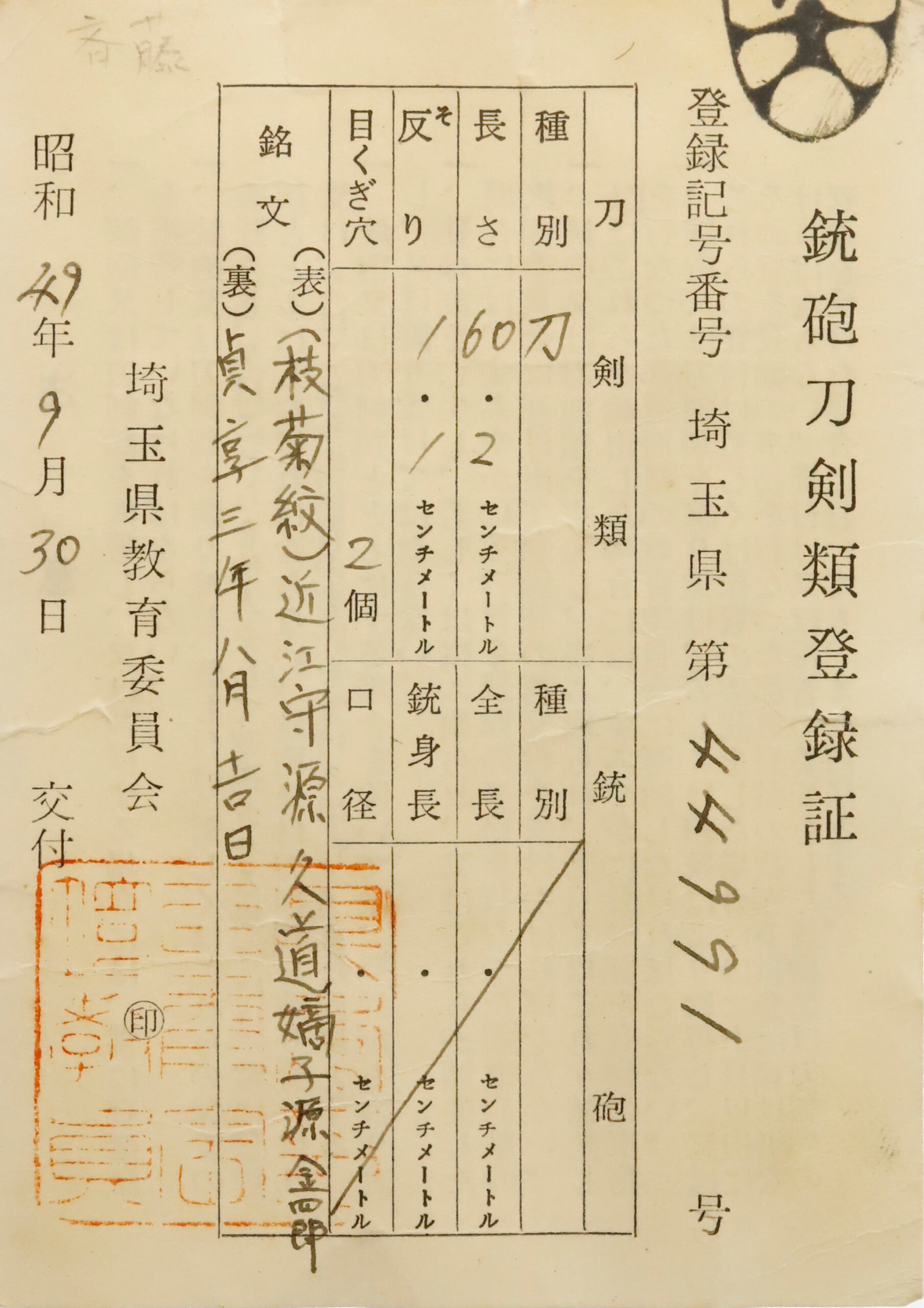
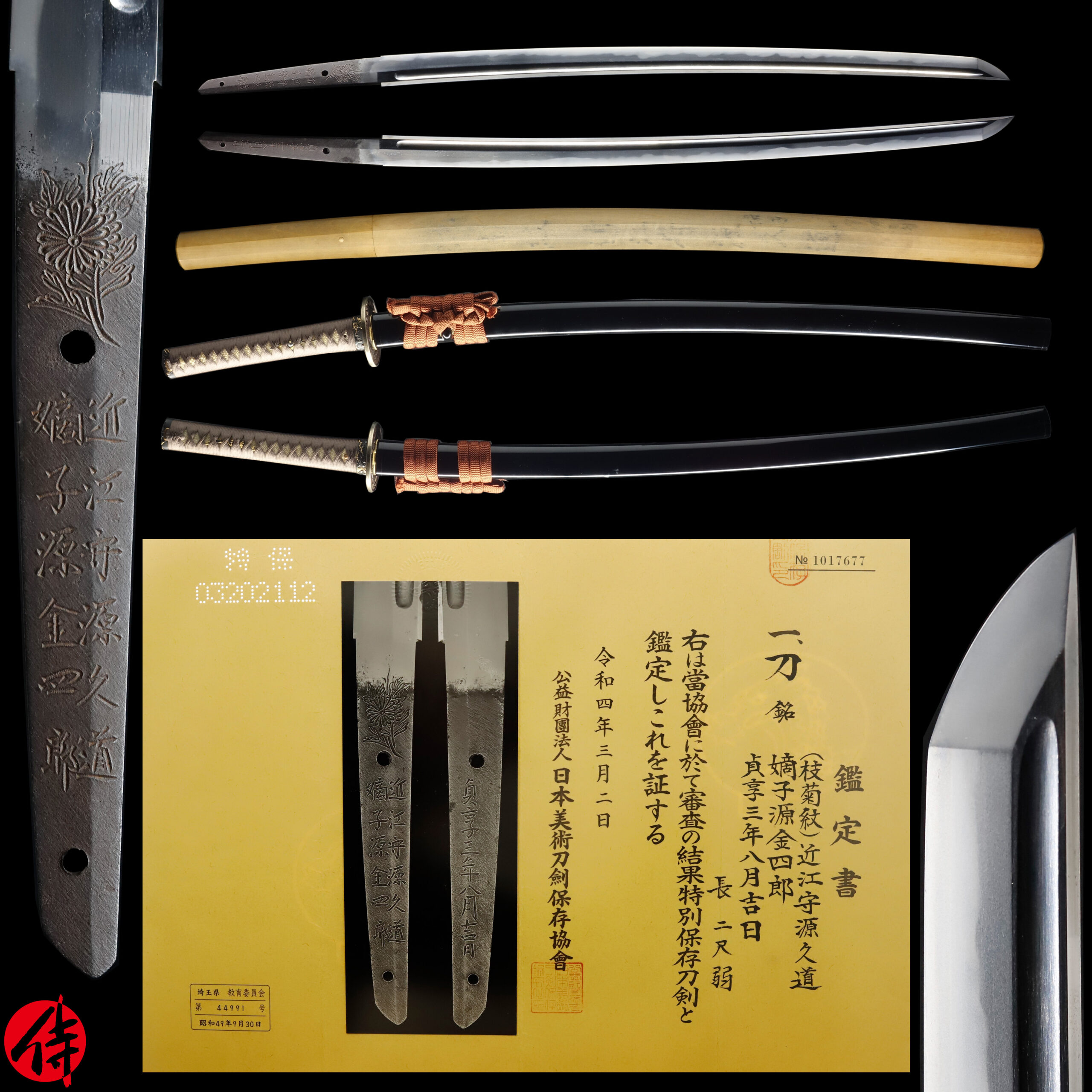
【About us】
Samurai Museum is located in Tokyo, Japan, exhibiting antique artifacts related to the Samurai history. Samurai Museum Shop is the place for those who are interested in Japanese culture and craftsmanship. We deal with antique Samurai swords/armor, traditional crafts made in Japan and so on.
【Japanese Sword& Export Process】
The Japanese swords we deal with are hand-forged edged swords made in Japan. It was made from the traditional carbon steel called TAMAHAGANE (玉鋼). Samurai Museum is familiar with the proper legal procedure for an antique / authentic Japanese sword to be exported from Japan. We have sent more than 500 Japanese swords for the past three years (~2023) to amazing owners who appreciate its historical value.
Each Japanese sword is registered under the Agency for Cultural Affairs and the Board of Education in Japan. They issue a registration paper for each Japanese sword for its owner in Japan to legally possess it. The Japanese sword with its registration paper means it was traditionally hand-forged in Japan.
To legally export the sword from Japan to other countries, we will have to apply for its permit to the Agency for Cultural Affairs(Bunkacho) and return the original registration paper to the Board of Education. It normally takes around 2-4 weeks to receive this permit after submitting required documents. And we would like you to expect at least 1-1.5 months for your order to arrive at your given address after you ordered. For more detailed info, please click here.
It is allowed for residents in Japan to own authentic Japanese swords without a special license as long as they come with registration papers. Please feel free to contact us if you are a resident of Japan, whether temporarily or permanently. We will also assist you when you leave Japan and need to obtain an export permit. If you live in Japan, please click here before you make a purchase.
【Payment Method】
We accept payment through Stripe (Credit card), PayPal, Apple Pay or ChromePay, all of which are secure payment methods. Also, you don’t need to make an account on Stripe for the checkout. If you prefer other payment method, please contact us. After confirming your payment, we will apply for an export permit. You may either pay in JPY, USD, AUD, CAD, EUR, CHF or GBP. The price is set in Japanese Yen. Prices in other currencies are automatically calculated based on the latest exchange rate.

*If the amount is above 1 million JPY, Stripe or wire transfer will be the only options for payment.
【Shipping】
We have shipped authentic Japanese swords to the USA, UK, Canada, Mexico, Germany, France, Hong Kong and Australia. If you don’t live in these countries and like to order, please contact us first before making a purchase. We offer Free International Shipping as long as we can send antique Japanese swords by EMS.
We normally ship by EMS (Express Mail Service) provided by Japan Post. We will send you a tracking number for your order as soon as we hand it to the post office. We will put 100 % insurance on the shipping document without any extra charge. Based on the total amount, there might be a duty tax or other fee for you to pay, depending on the countries. We use package cushioning to protect the item and put it in a PVC pipe, which is one of the most secure packages because of its durability.
It will normally takes 5-14 days for the item to arrive at your given address after we dispatch it. Time of delivery is estimated as accurately as possible by the carrier but does not take into account any delays beyond our control such as by inclement weather, post office holiday seasons.
*If you live in Australia and like to purchase an authentic Japanese sword, please click here to know the detail.
*Please keep in mind that due to the spread of COVID-19, there might be delays in shipping. If you like to know the detail about shipping, please feel free to ask us.

【Review】
Here is one of the reviews we received from a customer who purchased an authentic Japanese sword from us. For more reviews, please click here.
“My experience overall with the whole process was wonderful. I had many questions about the history and process to purchase these treasures. All my questions were answered very timely and complete. The staff is very knowledgeable and very well versed if any questions do arise.”
【How to make sure the condition】
Please keep in mind that what you are going to purchase is an antique item. We uploaded high resolution photos for you to check its condition thoroughly. If you like to see more photos with different angles, please feel free to contact us. We will be happy to send them to you so that you can make informed decision. It is essential for us to know that you are happy with your choice of a sword. and we are prepared to use the best of our ability to serve you.
【How To Contact Us】
Please contact us through email, Facebook Messenger or Live Chat if you have any questions. You can find each icon on the right side of the website. Please click one of them to reach us. We will reply to you within 1-2 business days.
【The Art of Nihonto (Japanese Sword)】
Samurai’s history is a profound, eloquent legacy of ancient Japanese warriors in which millions of people worldwide are being fascinated. If you like to find out the art of Nihonto, please click here.
【A Guide to Japanese Sword Maintenance】
After acquiring an genuine Japanese sword, it is also important to know how to take good care of it. Here is the special video for you. Mr. Paul Martin, Japanese sword expert, shows you how to give proper maintenance to your sword. By mastering how to clean the Japanese sword, its aesthetic beauty will last forever.
When you purchase a Japanese sword from us, you can get a Free Japanese sword maintenance kit. It comes with four tools (Choji Oil, Uchiko Whetstone Powder, Peg remover, Oil Applicator). By watching the video instruction above, you can enjoy learning how to maintain your Japanese sword while appreciating it. If you have any difficulty assembling the sword or cleaning the blade, you can feel free to contact us.


MORE ANTIQUE JAPANESE SWORD FOR SALE
SWORDS WITHOUT CERTIFICATES FOR SALE
LEARN JAPANESE SWORD TERMINOLOGY
Thank you for reading all the information on the page. If you have any difficulty choosing the right Japanese sword for you, we will be more than happy to help you find the one that speaks to you the most. Please feel free to contact us.
